D Link CS932LA1 Wireless N Day/Night Home Network Camera User Manual DCS 932 UserMan 2
D Link Corporation Wireless N Day/Night Home Network Camera DCS 932 UserMan 2
D Link >
Contents
(DCS-932)UserMan-2
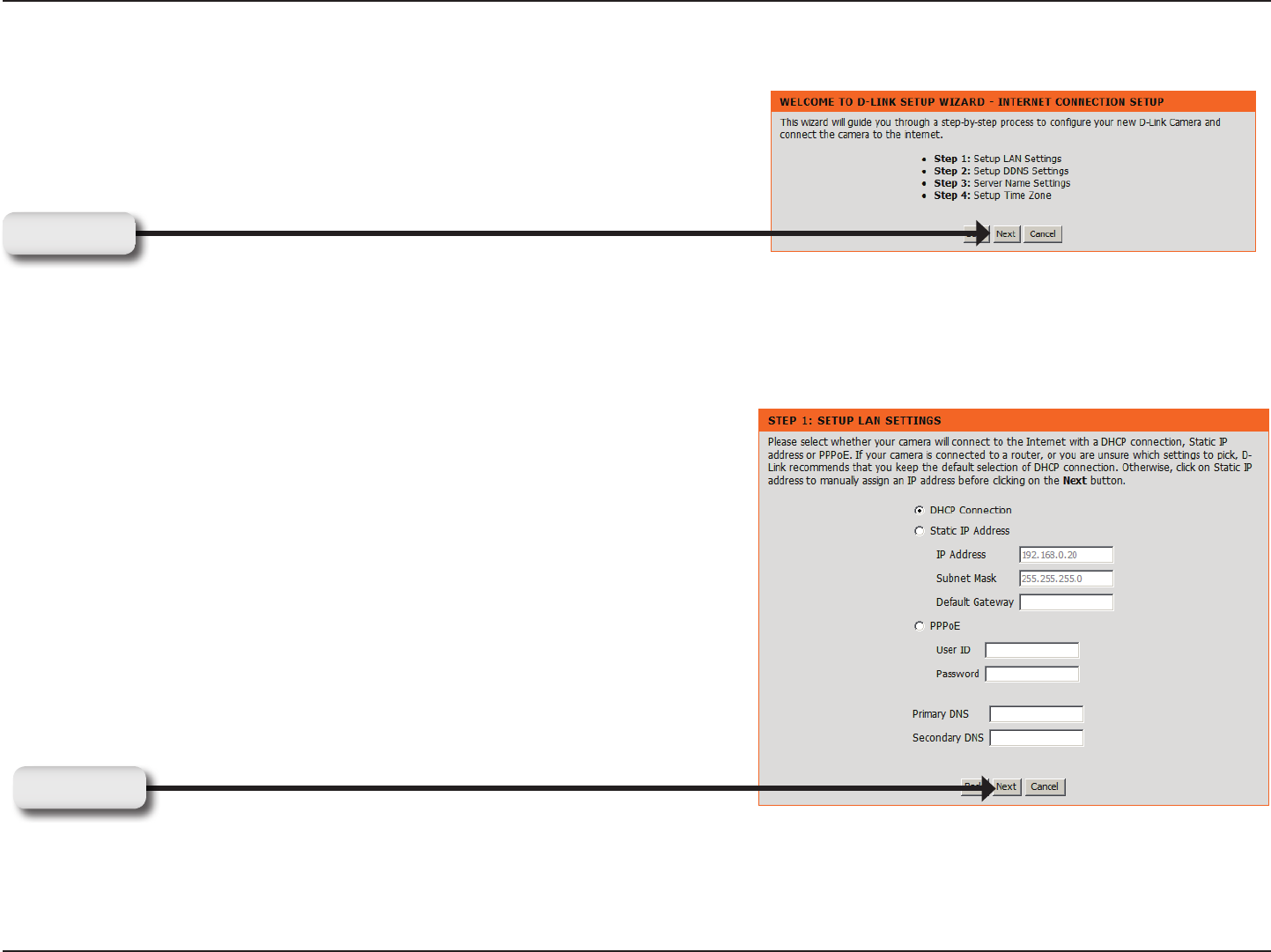
16D-Link DCS-932 User Manual
Section 3 - Configuration
Internet Connection Setup Wizard
This wizard will guide you through a step-by-step process to congure your
new D-Link Camera and connect the camera to the Internet.
You may congure your camera using
• DHCP Connection (by default), where your DHCP server will
automatically assign dynamic IP to your device.
• Static IP Address if your ISP has already assigned an IP address to
you.
• PPPoE connection, where your camera is directly connected to the
Internet through a DSL modem.
* Input the DNS information if you have chosen and assigned a Static IP
Address for your camera.
Click Next
Click Next
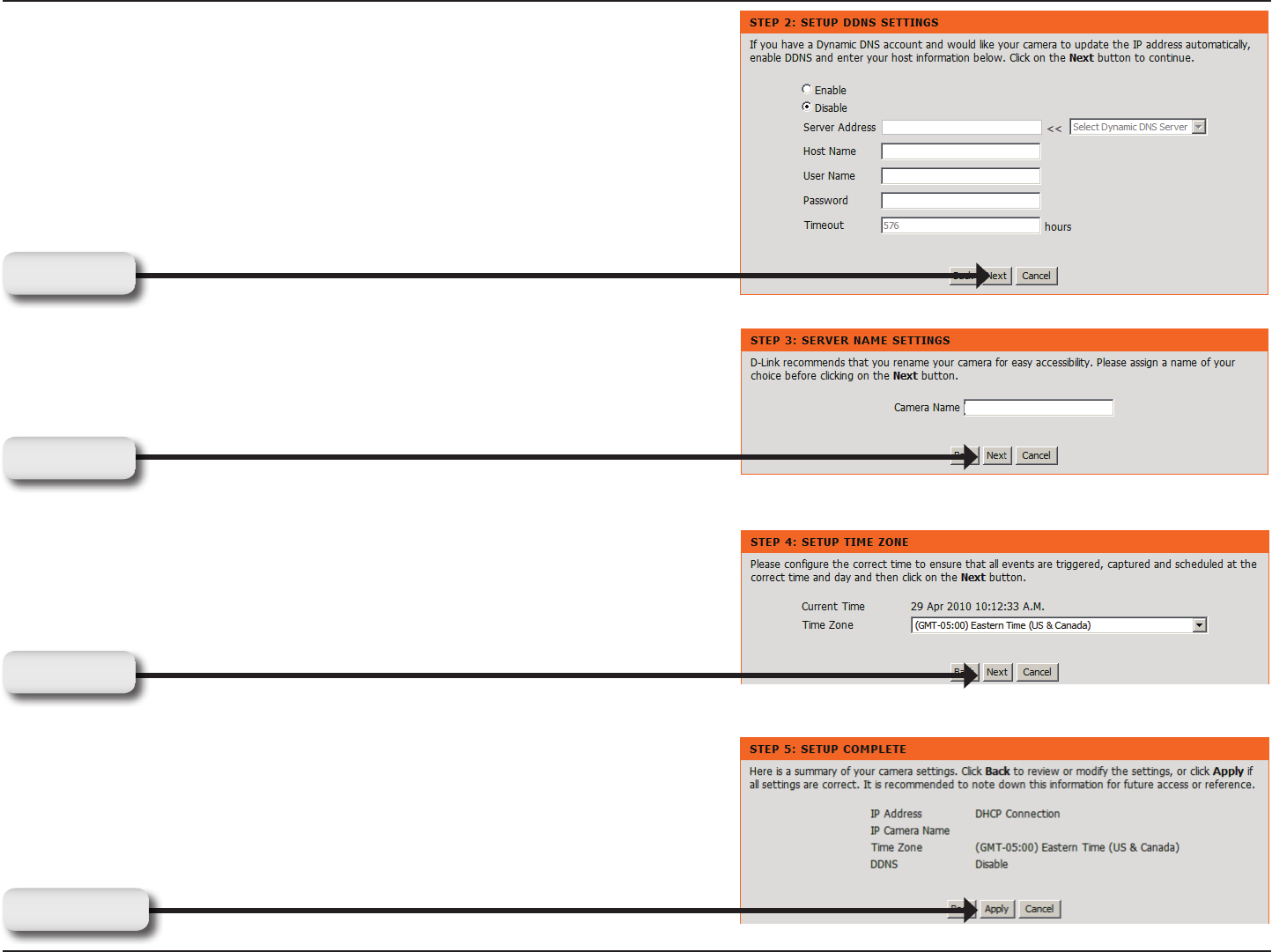
17D-Link DCS-932 User Manual
Section 3 - Configuration
DCS-932
DCS-932
Enter a name for your camera.
Congure the correct time to ensure that all events triggered, captured and
scheduled at the right time.
This page displays your congured settings. Click Apply to save and
activate the setting, or Back to change your settings.
If you have a Dynamic DNS account and would like the camera to
update your IP address automatically, enable DDNS and enter your host
information.
Click Next
Click Next
Click Next
Click Apply
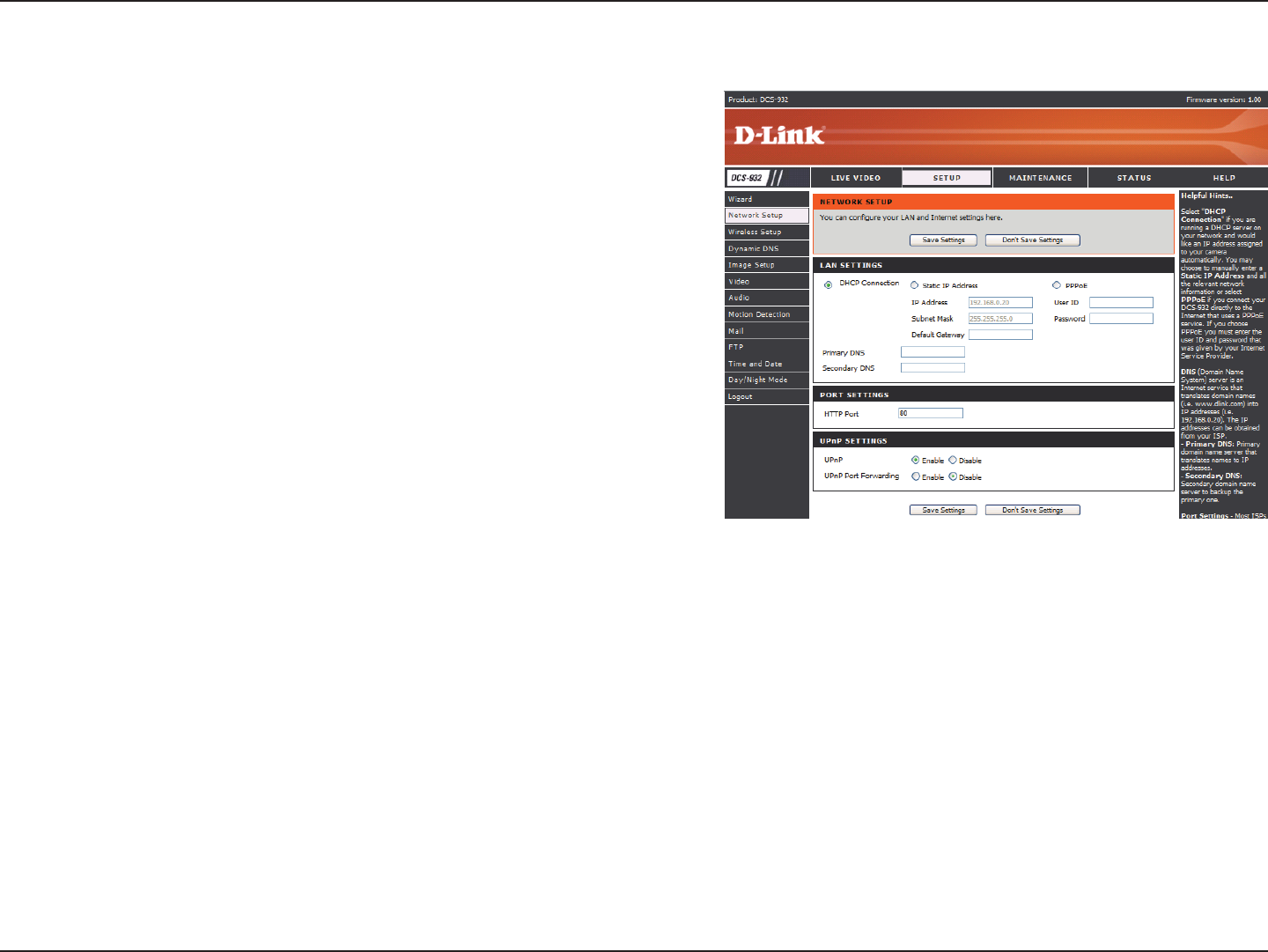
18D-Link DCS-932 User Manual
Section 3 - Configuration
Network Setup
Select this connection if you have a DHCP server running
on your network and would like a dynamic IP address to be
updated to your camera automatically.
You may obtain a static or xed IP address and other network
information from your network administrator for your camera. A
static IP address will ease you for accessing your camera in the
future.
IP Address: The xed IP address
Subnet Mask: The default value is “255.255.255.0.” Used to
determine if the destination is the same subnet.
Default Gateway: The gateway used to forward frames to
destinations in a different subnet. Invalid gateway settings may
cause the failure of transmissions to a different subnet.
Primary DNS: Primary domain name server that translates names to IP addresses.
Secondary DNS: Secondary domain name server to backup the Primary DNS.
DHCP:
Static IP Client:
PPPoE Settings:
Port Settings:
UPnP Settings:
This section allows you to congure your network settings.
If you are using a PPPoE connection, enable it and enter the User Name and Password for your PPPoE account. You can get
this information from your Internet service provider (ISP).
You may congure a Second HTTP port that will allow you to connect to the camera via a standard web browser. The port can be
set to a number other than the default TCP ports 80. A corresponding port must be opened on the router. For example, if the port
is changed to 1010, users must type “http://192.168.0.100:1010” instead of only “http://192.168.0.100”.
Enable this setting to congure your camera as an UPnP device in the network.
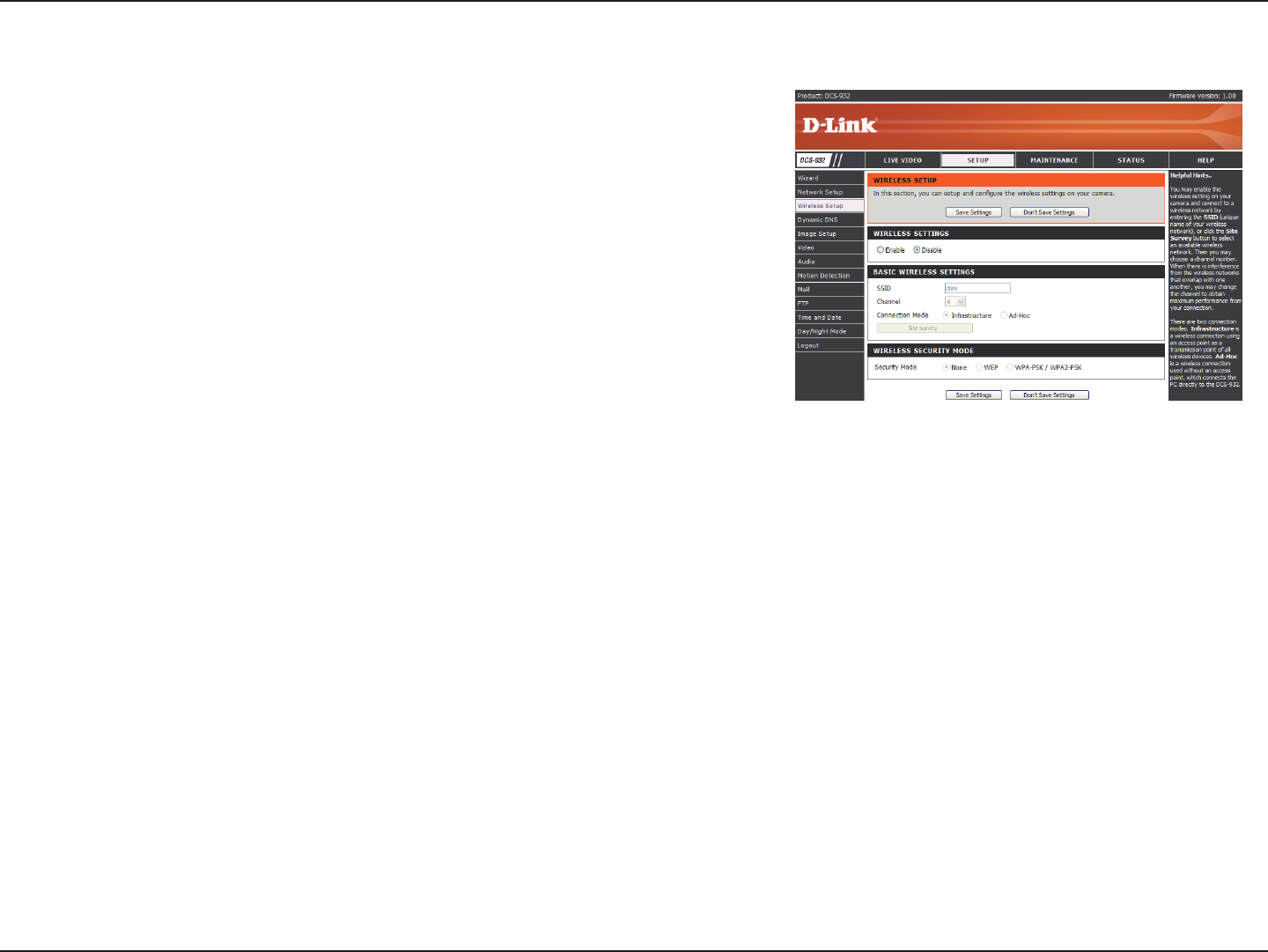
19D-Link DCS-932 User Manual
Section 3 - Configuration
Setup > Wireless
Service Set Identier, an identier for your wireless network.
The default setting is channel 6. Select the same channel that is using by other wireless devices within your network. When
there is interference from the wireless networks that overlap with one another, you may change the channel to obtain maximum
performance for your connection.
Infrastructure is a wireless connection using an access point as a transmission point of all wireless devices. Ad-Hoc is a
wireless connection used without an access point, where your DCS-932 is directly connecting to your PC. This is done using
the on-board wireless adapter on the DCS-932 connected to a wireless adapter on the PC.
This page will allow you to select a wireless network that the DCS-932 was able to detect.
For security, there are three choices; None, WEP, and WPA-PSK / WPA2-PSK. Select the same encryption method that is being
used by your wireless device/ router.
An appropriate Preshared Key, which is needed in order to connect to the wireless network..
SSID:
Channel:
Connection Mode:
Site Survey:
Wireless Security
Mode:
WPA-PSK /
WPA2PSK
Settings:
Wireless Interface
This section allows you to setup and congure the wireless settings
on your camera.
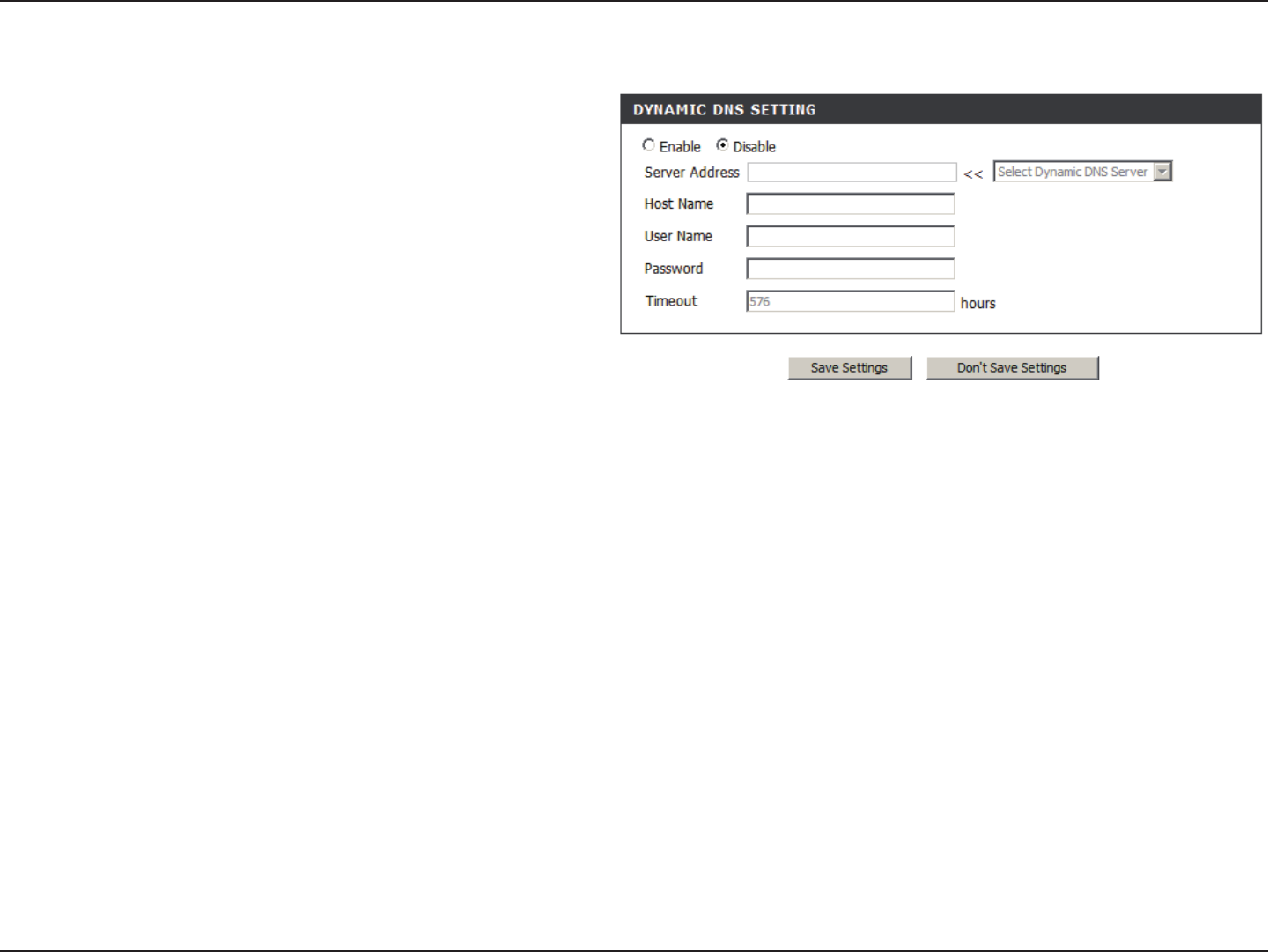
20D-Link DCS-932 User Manual
Section 3 - Configuration
(Dynamic Domain Name Server) will hold a DNS host name and synchronize the public IP address of the modem when it
has been modied. The username and password are required when using the DDNS service.
Click to enable the DDNS function.
Select your Dynamic DNS Server from the pull down menu.
Enter the host name of the DDNS server.
Enter your username or e-mail used to connect to the DDNS.
Enter your password used to connect to the DDNS server.
DDNS:
Enable:
Server Address:
Host Name:
User Name:
Password:
Setup > DDNS
This section allows you to congure the DDNS setting for your
camera. DDNS will allow all users to access your camera using
a domain name instead of an IP address.
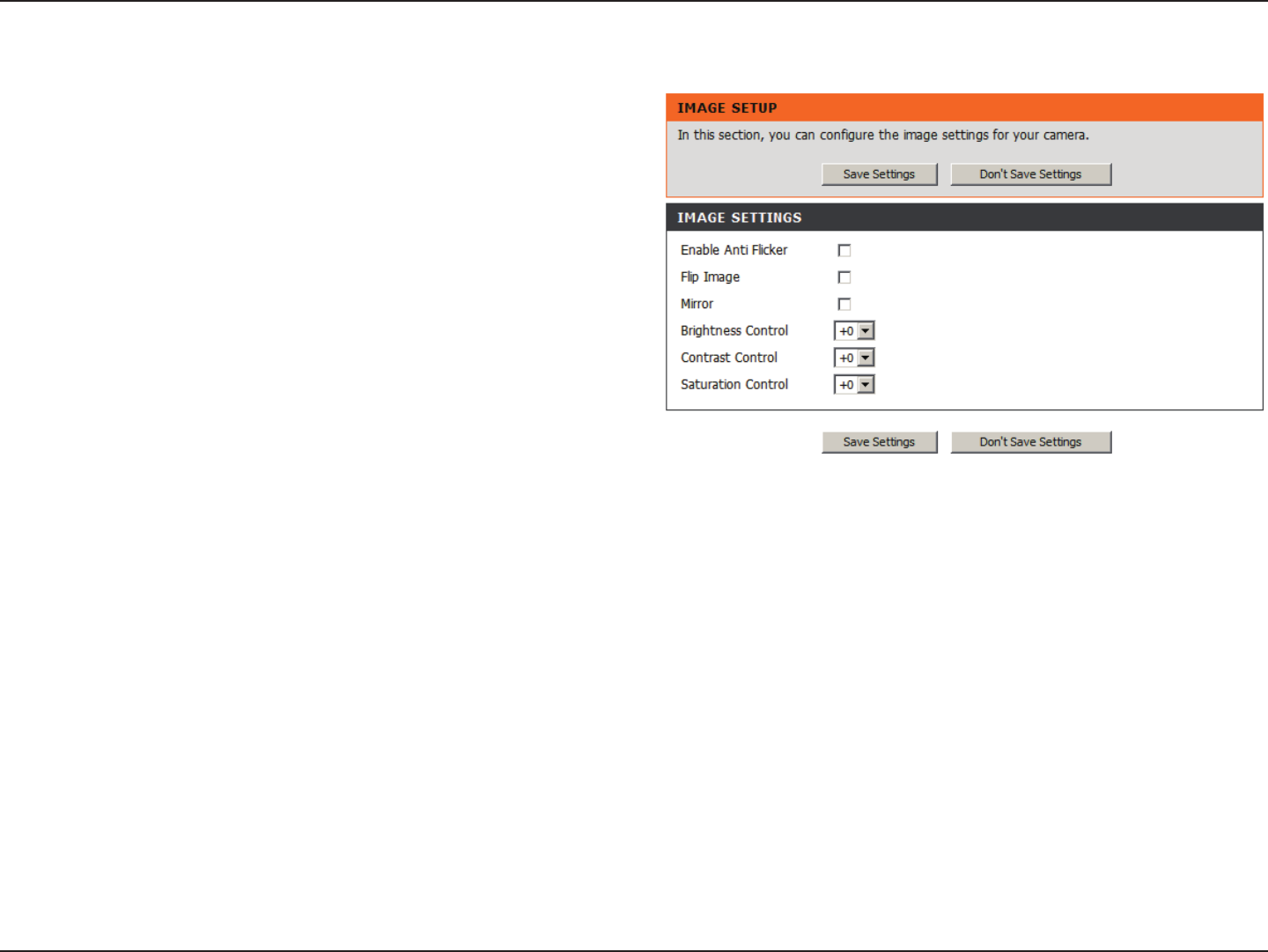
21D-Link DCS-932 User Manual
Section 3 - Configuration
Setup > Image Setup
Select this box to enable antiicker.
Select this box to vertically rotate the video. If the camera is installed upside down, Flip Image and Mirror should both be
checked.
Horizontally rotates the video.
Allows you to adjust the brightness level.
Allows you to adjust the contrast level.
Allows you to adjust the saturation level.
Enable
Antiicker:
Flip Image:
Mirror:
Brightness
Control:
Contrast
Control:
Saturation
Control:
Image Settings
This section allows you to congure the image settings for your
camera.
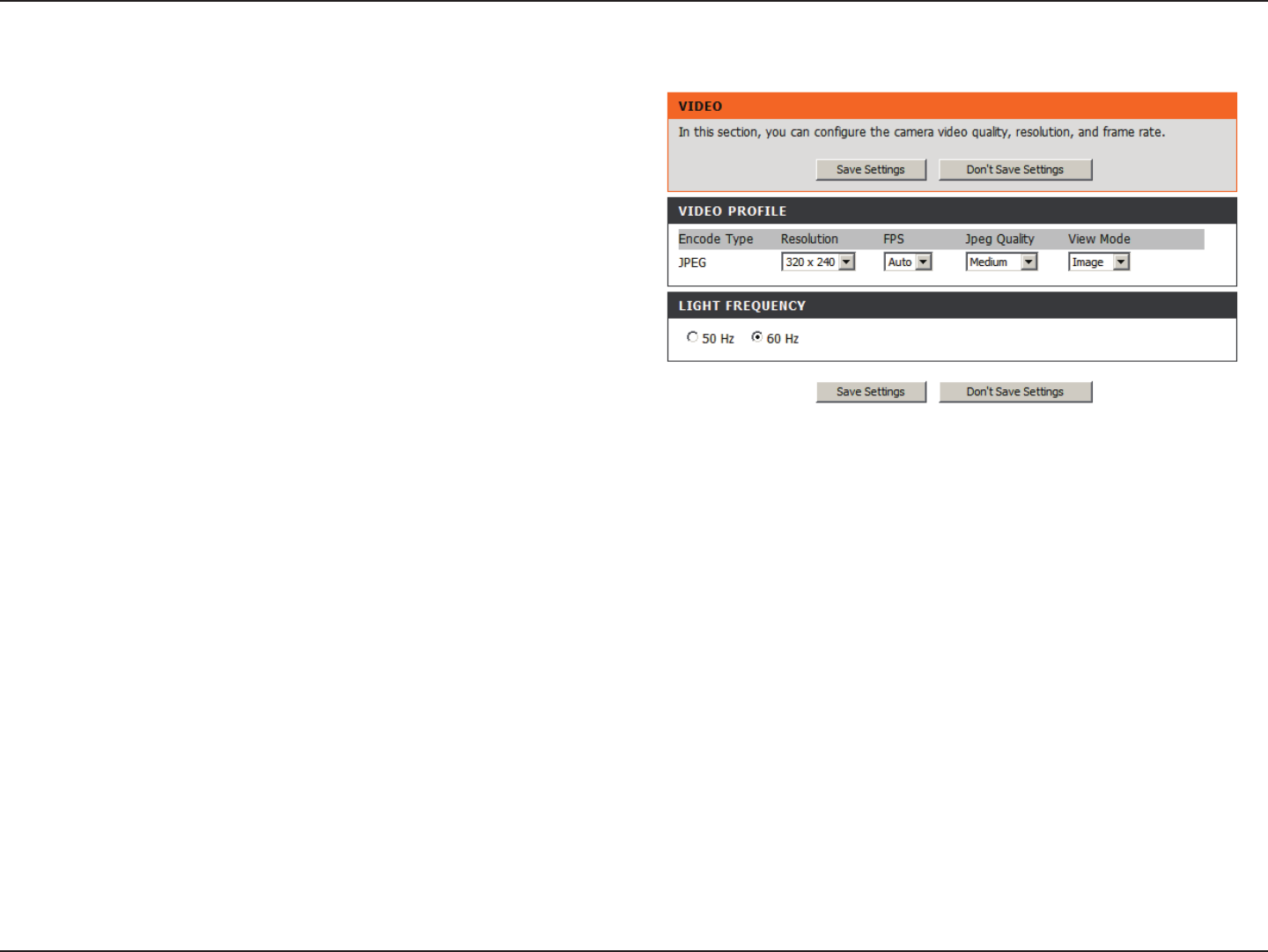
22D-Link DCS-932 User Manual
Section 3 - Configuration
Setup > Video
Video Prole:
Light
Frequency:
Video Conguration
Encode Type:
Resolution:
FPS:
JPEG Quality:
View Mode:
The compression format used when viewing your camera.
Select the desired video resolution from three formats: 640x480, 320x240, and 160x120. The higher setting can
obtain better quality. However, it will use more resource within your network.
Select the optimal setting depending on your network status. Please note that the higher setting can obtain better
quality. However, it will use more resources within your network.
Choose one of ve levels of image quality: Highest, High, Medium, Low, and Lowest.
Select the mode for viewing the camera image. Select Image for a still images, ActiveX for Internet Explorer, or
Java for other web browsers.
Select the proper frequency (50Hz or 60Hz) to reduce image icker.
This section allows you to congure the video settings for
your camera.
This section allows you to change the Encode Type, Resolution, FPS, and Quality.
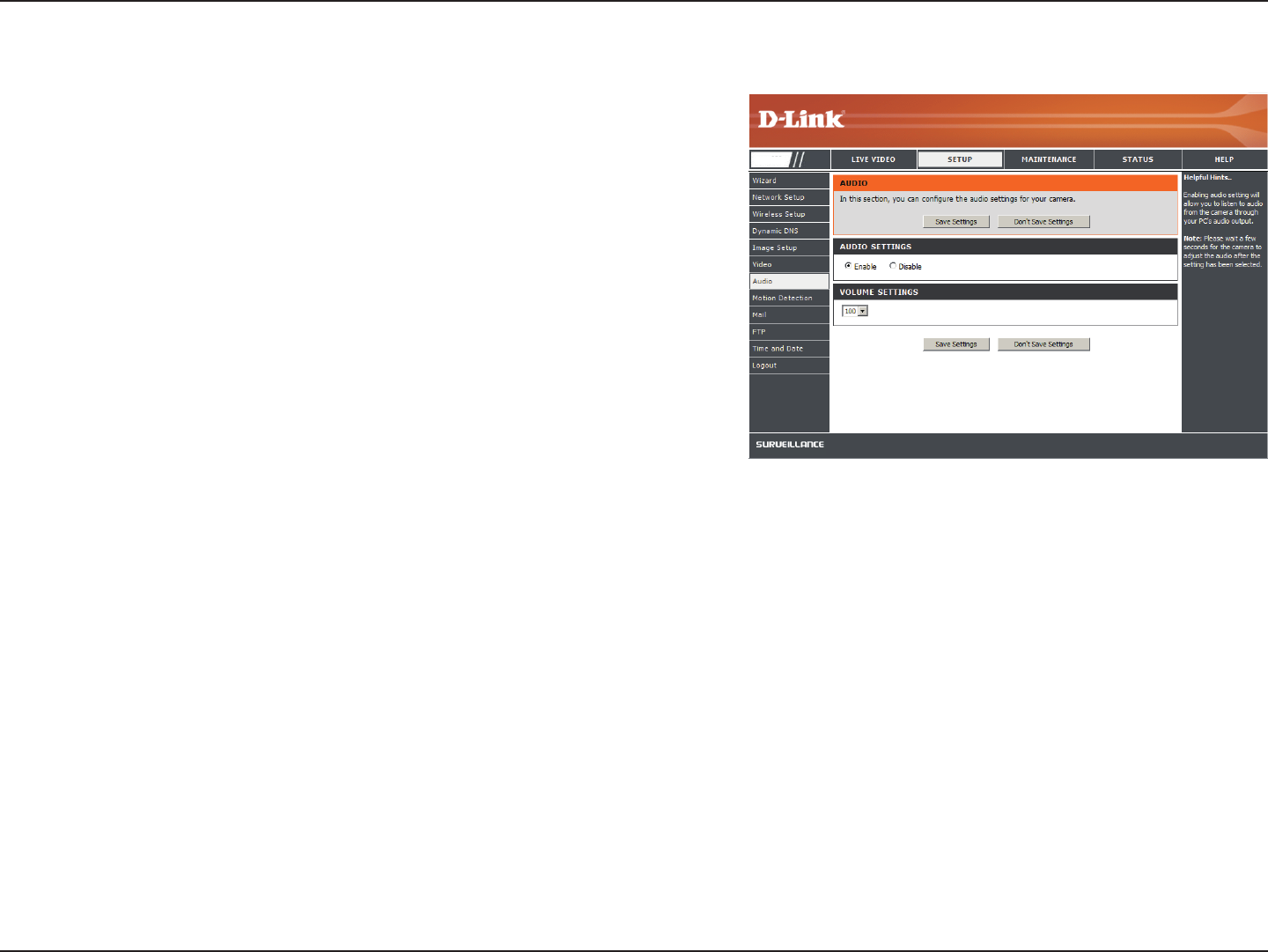
23D-Link DCS-932 User Manual
Section 3 - Configuration
Setup > Audio
Enabling audio setting will allow you to listen to audio from the camera
through your PC’s audio output.
Note: Please wait a few seconds for the camera to adjust the audio
after the setting has been selected.
Audio Settings:
Volume
Settings:
You may Enable or Disable the camera audio feed.
Select the desired volume percentage level.
DCS-932
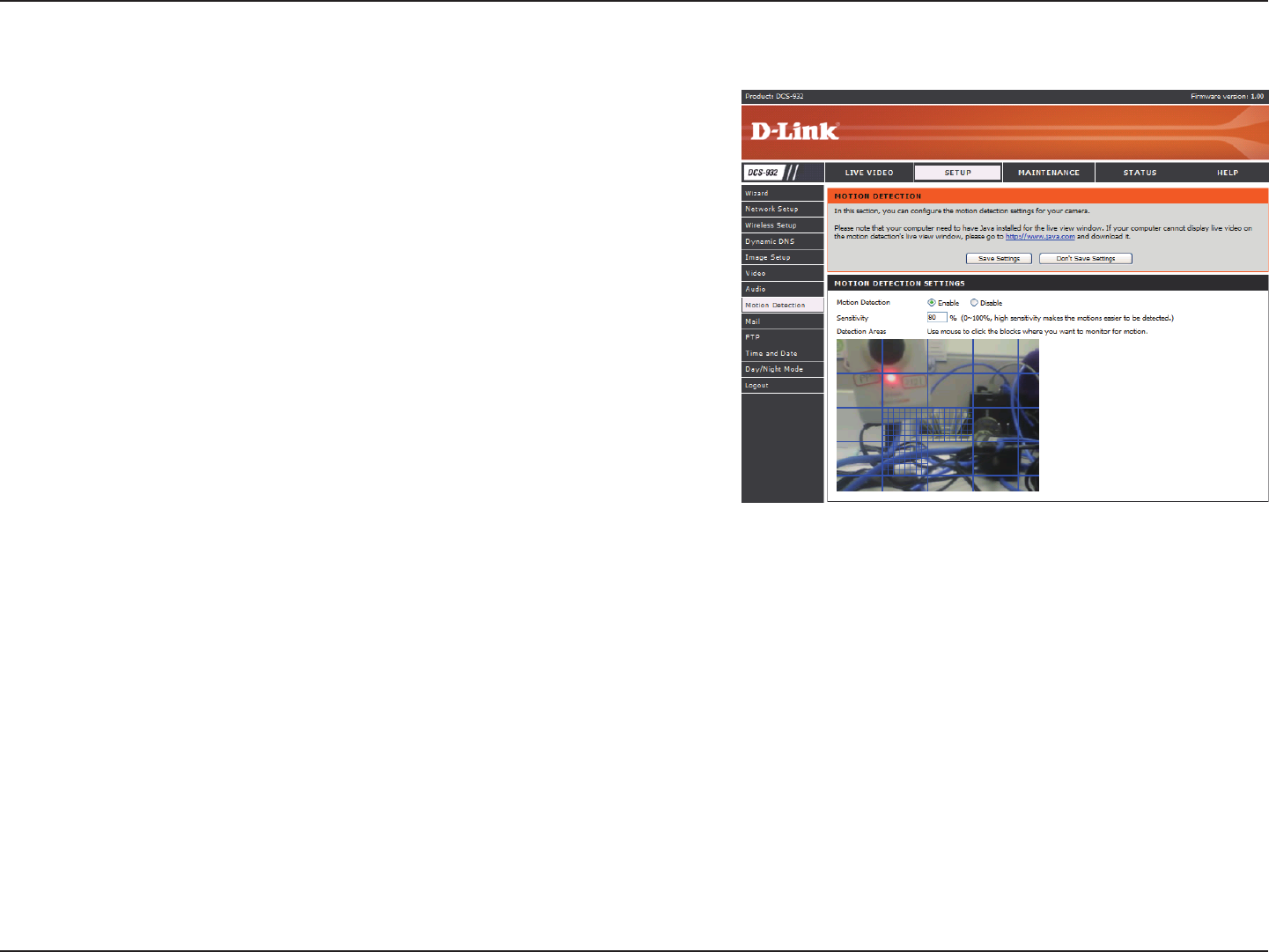
24D-Link DCS-932 User Manual
Section 3 - Configuration
Setup > Motion Detect
Enabling Video Motion will allow your camera to use the motion detection
feature. You may draw a nite motion area that will be used for monitoring.
Motion
Detection:
Sensitivity:
Detection
Areas:
Select this box to enable the motion detection feature of your
camera.
Species the measurable difference between two sequential
images that would indicate motion. Please enter a value
between 0 and 100.
Use your mouse to click on the blocks that you would like to
monitor for motion.
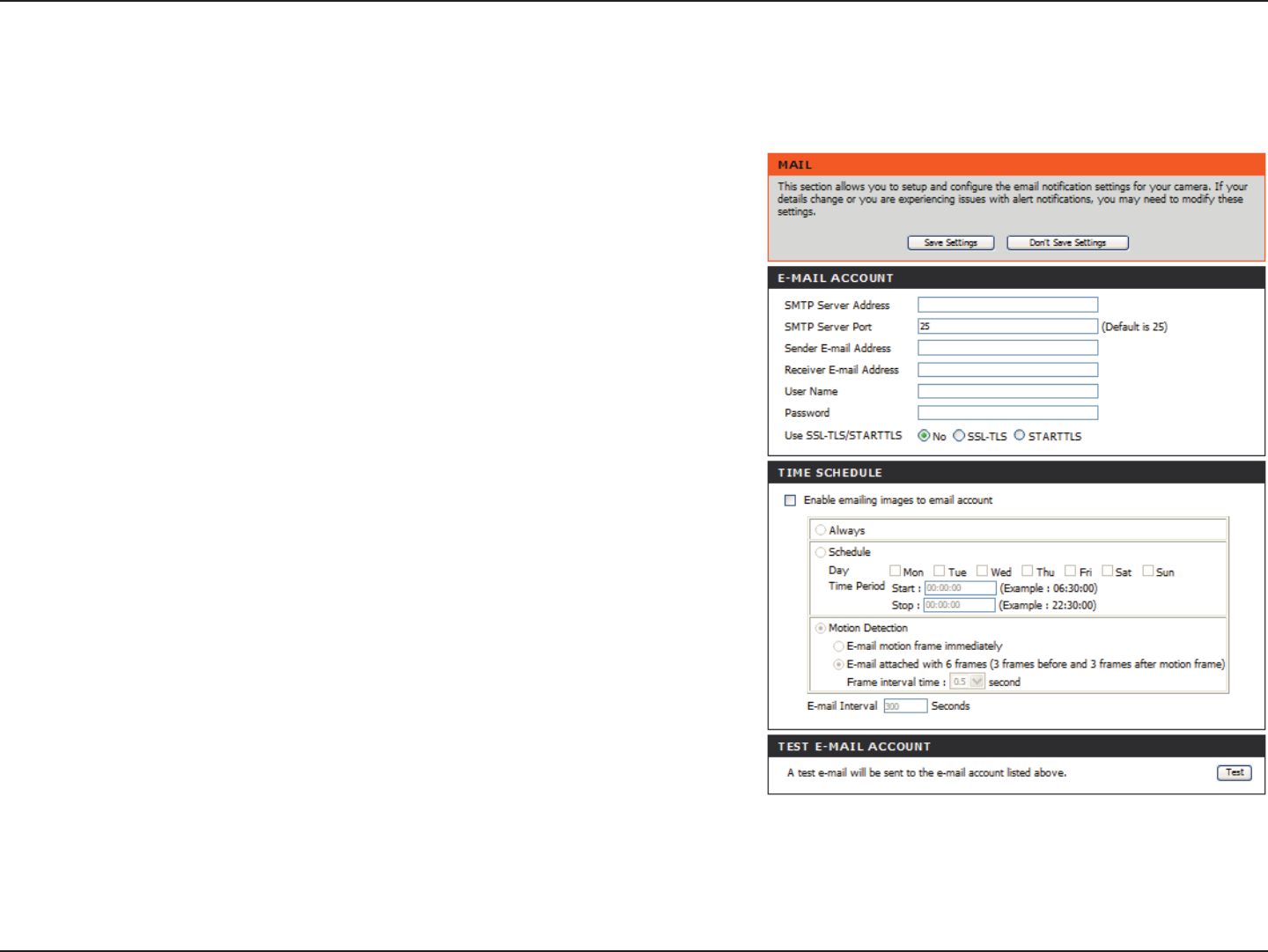
25D-Link DCS-932 User Manual
Section 3 - Configuration
Setup > Mail
Email Account
SMTP Server
Address:
Sender e-mail
Address:
Receiver e-mail
Address:
User Name:
Password:
This is the domain name or IP address of your external e-mail
server.
This is the e-mail address of the person sending the camera
snapshots.
This is the e-mail address of the recipient.
If the SMTP server uses authentication, you must enter your user
name here.
This is the password that corresponds to your user name to
connect to the SMTP server.
This section allows you to congure the email notication settings for your
camera.
Use SSL-TLS/STARTTLS: Select SSL-TLS or STARTTLS if SMTP server
requires TLS authentication.

26D-Link DCS-932 User Manual
Section 3 - Configuration
Time Schedule
Enable e-mail
image to e-mail
account:
Interval:
Test E-mail
Account:
Choosing Always will start sending snapshots to the recipient’s e-mail account right away. Choosing Schedule will allow you to
schedule when to start and stop the sending of snapshots to the recipient’s e-mail account.
Select Motion Detection if you would like to camera sending image to the recipient’s email account when the motions are detected.
The frequency of the snapshot interval can also be congured from 1 to 65535 seconds.
This will send a snapshot to the e-mail account that you have congured in the E-mail section. If you have congured the SMTP
account correctly, you will be able to send a test le to the e-mail account of the recipient.
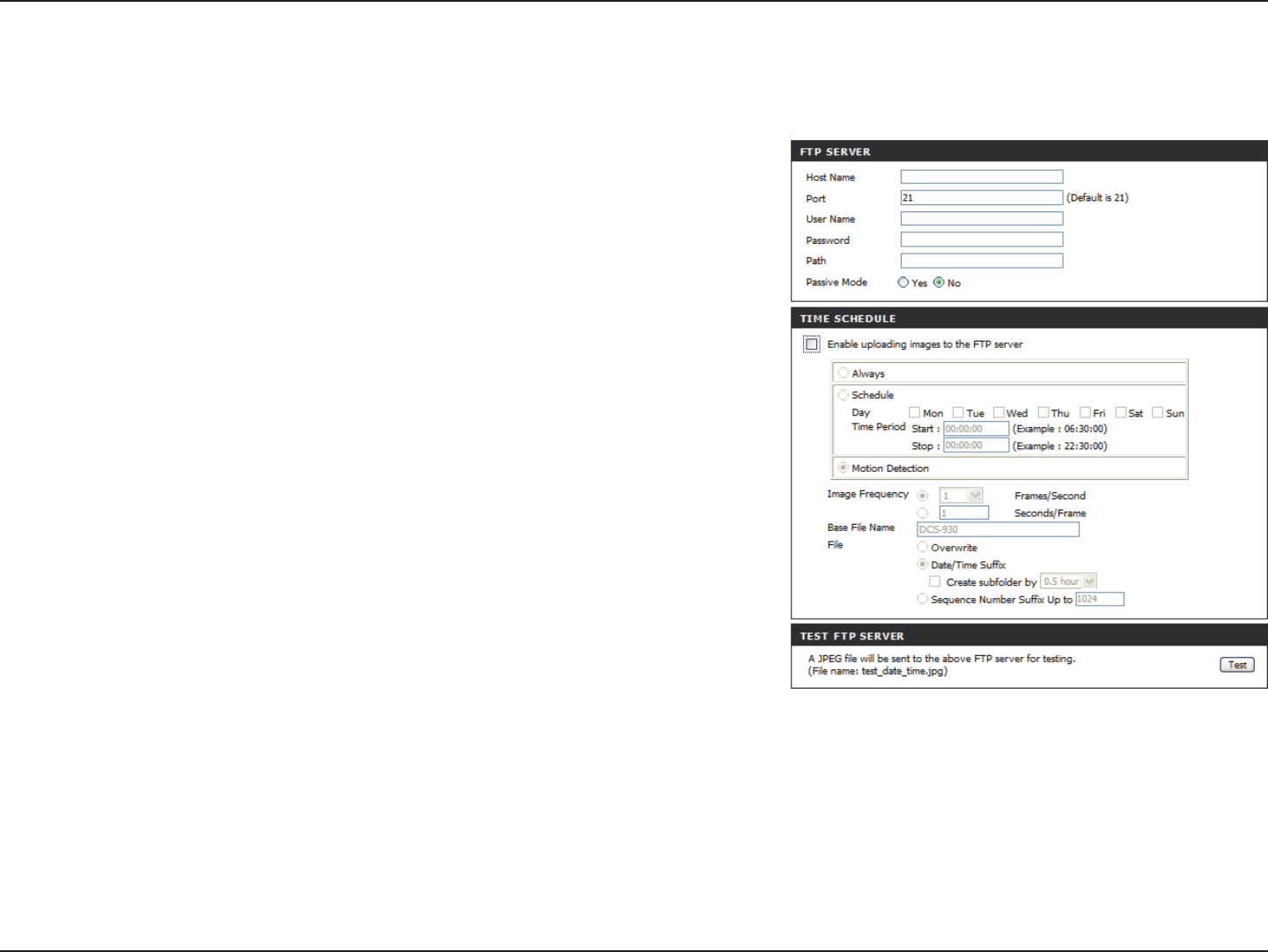
27D-Link DCS-932 User Manual
Section 3 - Configuration
Setup > FTP
FTP Server
Host Address:
Port Number:
User Name:
Password:
Directory Path:
Passive Mode:
This is the IP address of the FTP server that you will be connecting to.
Default is port 21. If changed, external FTP client program must change
the server connection port accordingly.
Species the user name to access the external FTP server. If you are
to upload snapshots to an FTP server you will need to ll in the Domain
name or IP address of your external FTP server. The following user
settings must be correctly congured for remote access.
Species the password to access the external FTP server.
Species the destination folder in the external FTP server.
Enabling passive mode will allow access to an external FTP server if
your camera is behind a router protected by a rewall.
This section allows you to congure a FTP server to receive images from the camera.

28D-Link DCS-932 User Manual
Section 3 - Configuration
Time Schedule
Enable upload image to
FTP server:
Always:
Schedule:
Video Frequency:
Base File Name:
File:
Test FTP Server:
Checking this box will enable video uploads to the FTP server you have selected.
Selecting this option allows snapshots to be uploaded to your FTP as soon as you click Apply.
Selecting this option allows you to congure specic times when you want the snapshots to be uploaded to your FTP
server.
Users can select in frames per second (1, 2, 3 or auto, in auto this could go to 4). The user can also select a duration for
each frame from 1 to 65535 seconds.
This will be the name that precedes the time, for example DCS9302010072116425101.jpg. This means that the camera
took a snapshot in the year 2010, July 21 at 16th hour (4 o’clock), 42 minutes and 51 seconds and it is picture number
one.
Select Overwrite and there will be only one images that are constantly refreshed . Select Date/Time Sufx and the
pictures will be named with a date and time (may refer to Base File Name). Enable the Create subfolder function, the
system will auto create the subfolder by 0.5 hour, 1 hour or 1 day. An example of this can be seen under the Base le
name category. Select Sequence Number Sufx up to 1024 and all the pictures will be numbered from 1-1024. The
total amount of pictures can be congured up to 1024 pictures.
This will send a snapshot to the FTP server that you have congured in the Upload section. If you have congured the
FTP correctly, you will be able to see a test le on your FTP server.
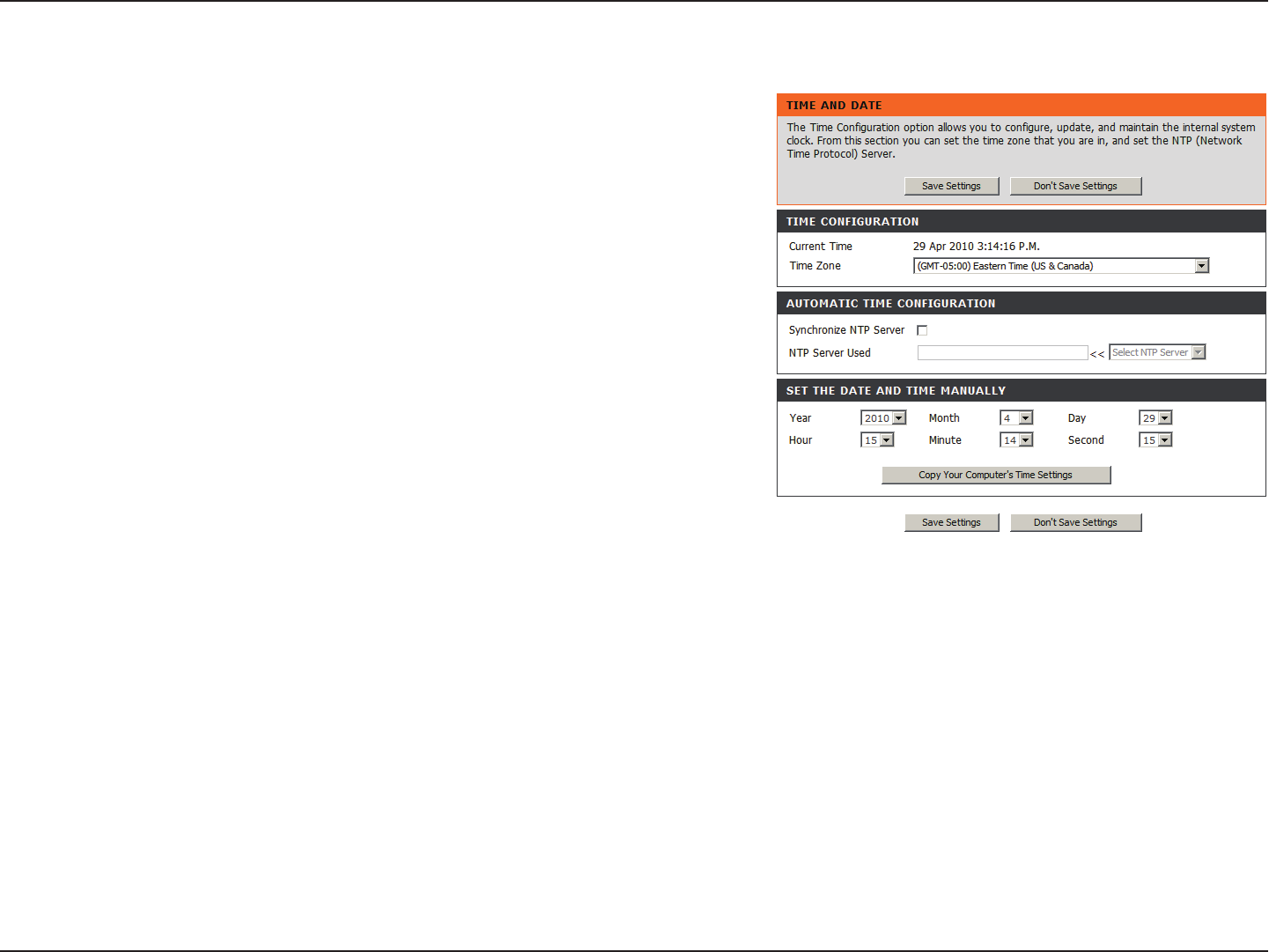
29D-Link DCS-932 User Manual
Section 3 - Configuration
Setup > Time and Date
Test FTP Server:
Synchronize NTP Server:
Copy your Computer’s
Time Settings:
Set the Date and Time
Manually:
Select the time zone for your region from the pull-down
menu.
Network Time Protocol will synchronize your camera with
an Internet time server. Choose the one that is closest to
your camera.
Click to synchronize the time information from your PC.
Select this to set the time manually.
This section allows you to congure the settings of the internal system clocks for
your camera.
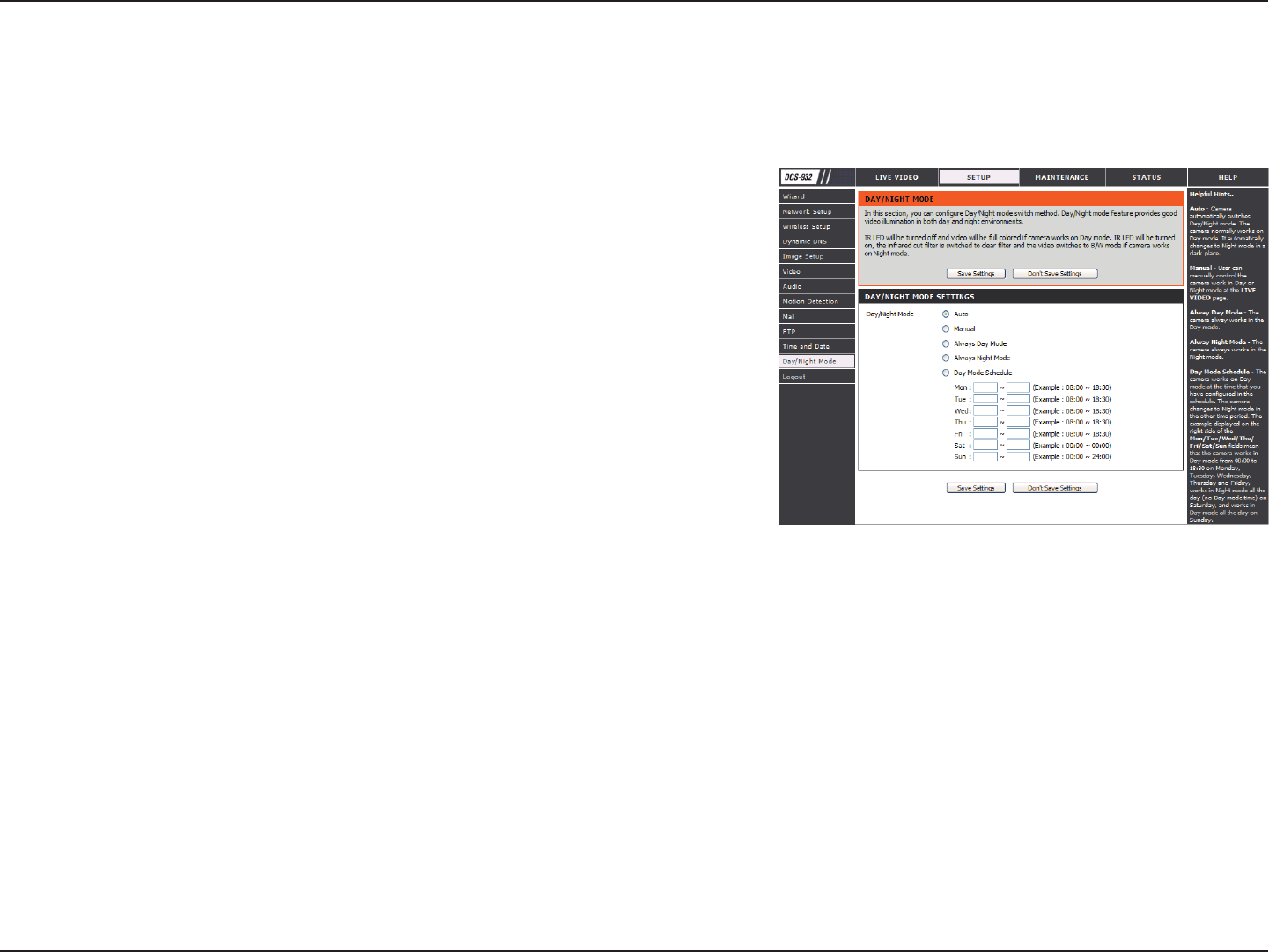
30D-Link DCS-932 User Manual
Section 3 - Configuration
Auto:
Manual:
Alway Day Mode:
Alway Night Mode:
Day Mode Schedule:
Camera automatically switches Day/Night mode. The
camera normally works on Day mode. It automatically
changes to Night mode in a dark place.
User can manually control the camera work in Day or Night
mode at the LIVE VIDEO page.
The camera alway works in the Day mode.
The camera always works in the Night mode.
The camera works on Day mode at the time that you have
congured in the schedule. The camera changes to Night
mode in the other time period. The example displayed on
the right side of the Mon/Tue/Wed/Thu/
Fri/Sat/Sun elds mean that the camera works in
Day mode from 08:00 to 18:30 on Monday, Tuesday,
Wednesday, Thursday and Friday, works in Night mode all
the day (no Day mode time) on Saturday, and works in Day
mode all the day on Sunday.
This section allows you to congure the settings of Day/Night mode switch method. Day/Night mode feature provides good video illumination
in both day and night environments.
Setup > Day/Night Mode
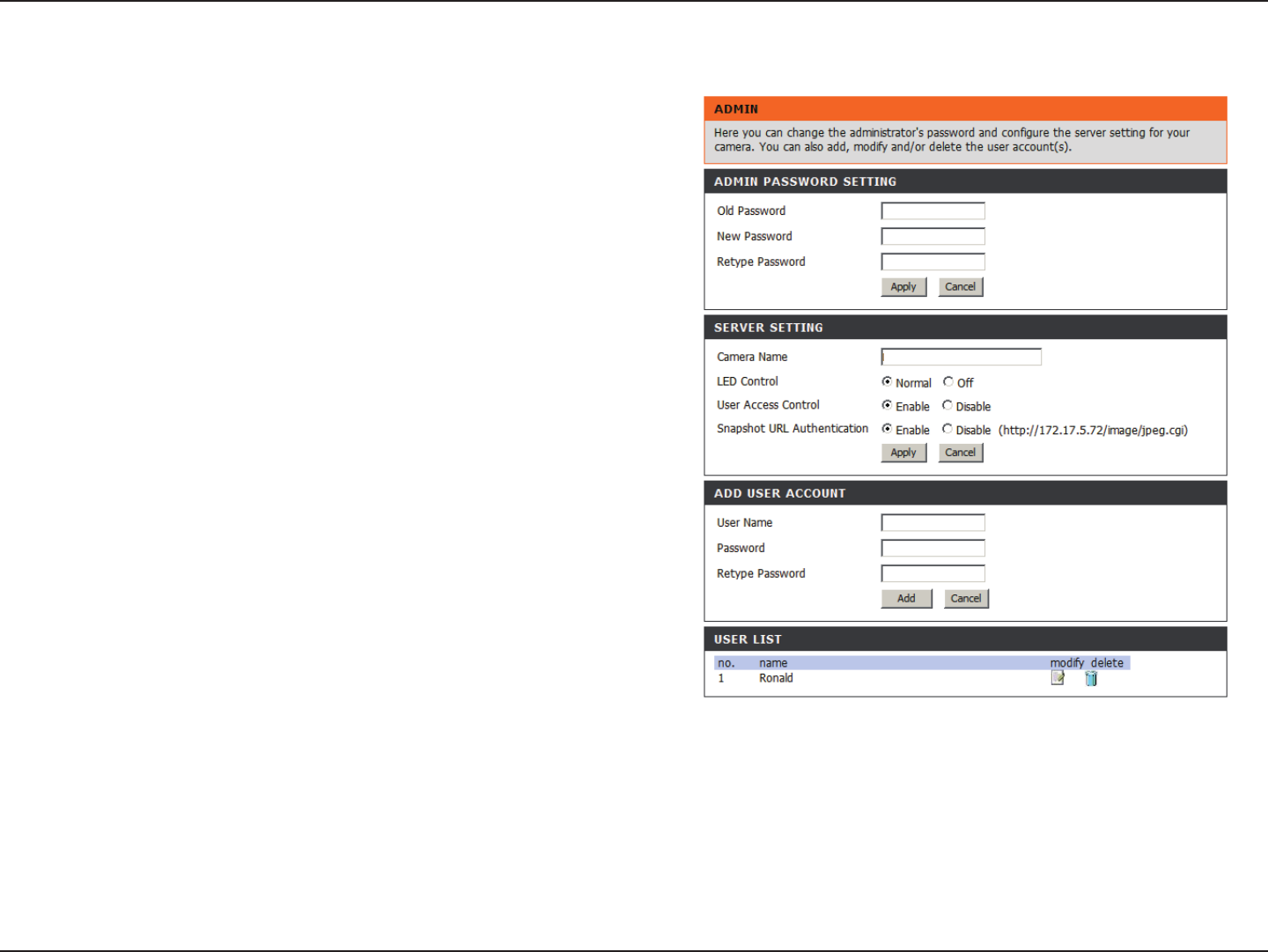
31D-Link DCS-932 User Manual
Section 3 - Configuration
Maintenance > Admin
This section allows you to change the administrator’s password and
congure the server settings for your camera. You can also manage
the user account(s) that access to your camera.
Camera Name:
LED Control:
User Access Control:
Snapshot URL
Authentication:
Add User Account:
User List:
Specity a name for your camera
Select Normal to enable the LED on the front of
the device, or select off to disable the LED.
Select Enable to enable user access control or
Disable to allow only the administrator account
to access the camera.
Select Enable to allow access to the current
camera snapshot via the web address indicated.
Create new user for accessing the video image.
Enter the user name, password, and password
conrmation, and click Add. A maximum of 8
user accounts can be added into the user list.
Displays the account names of authorized users.
DCS-932
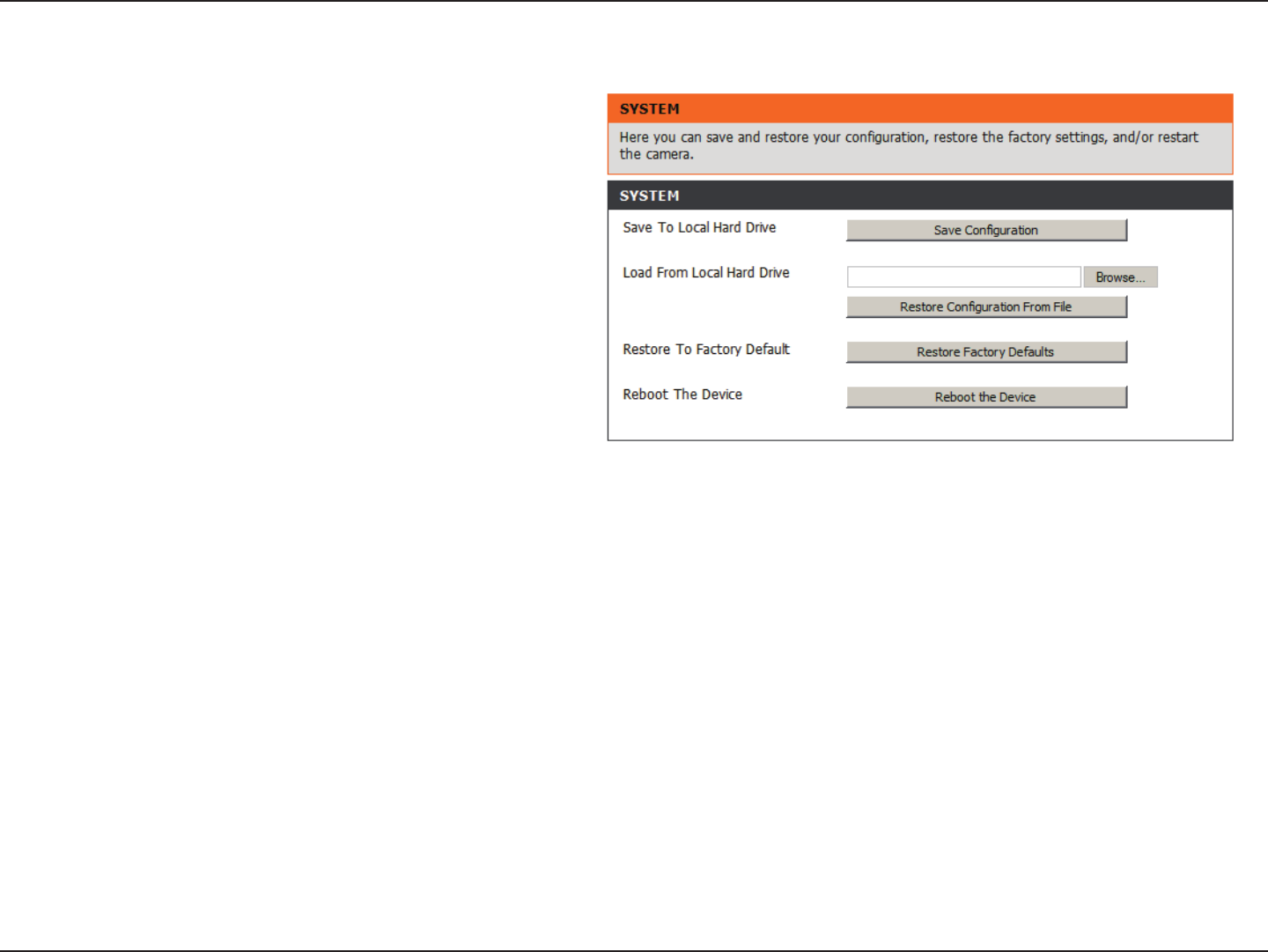
32D-Link DCS-932 User Manual
Section 3 - Configuration
Maintenance > System
This section allows you to save and restore your conguration,
restore the factory settings, and/or restart the camera.
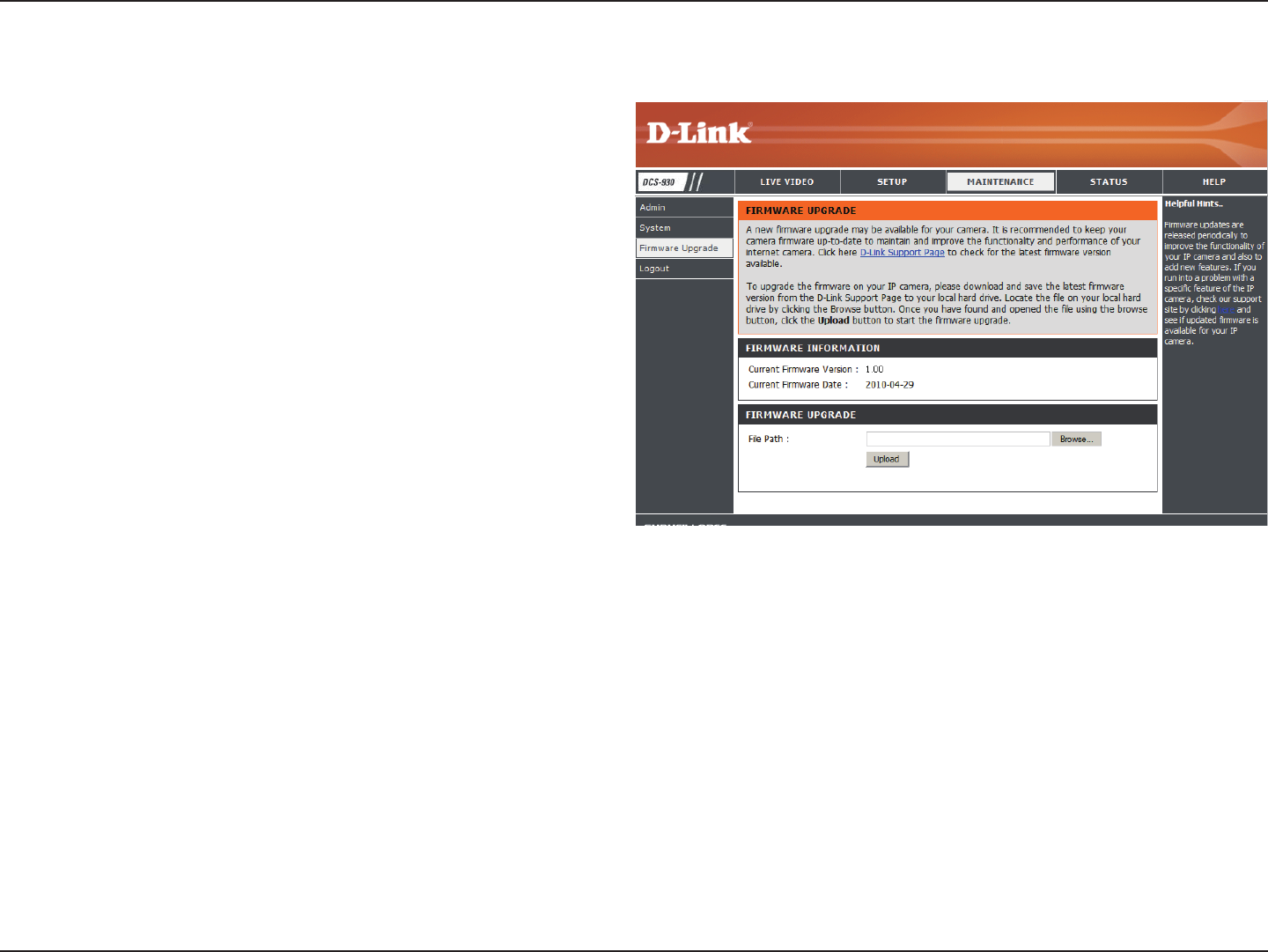
33D-Link DCS-932 User Manual
Section 3 - Configuration
Maintenance > Firmware Upgrade
Your current rmware version and date will be displayed on your
screen. You may go to the D-Link Support Page to check for the
latest rmware versions available.
To upgrade the rmware on your DCS-932, please download
and save the latest rmware version from the D-Link Support
Page to your local hard drive. Locate the le on your local hard
drive by using the Browse button. Then, open the le and click
the “Upload” button to start the rmware upgrade.
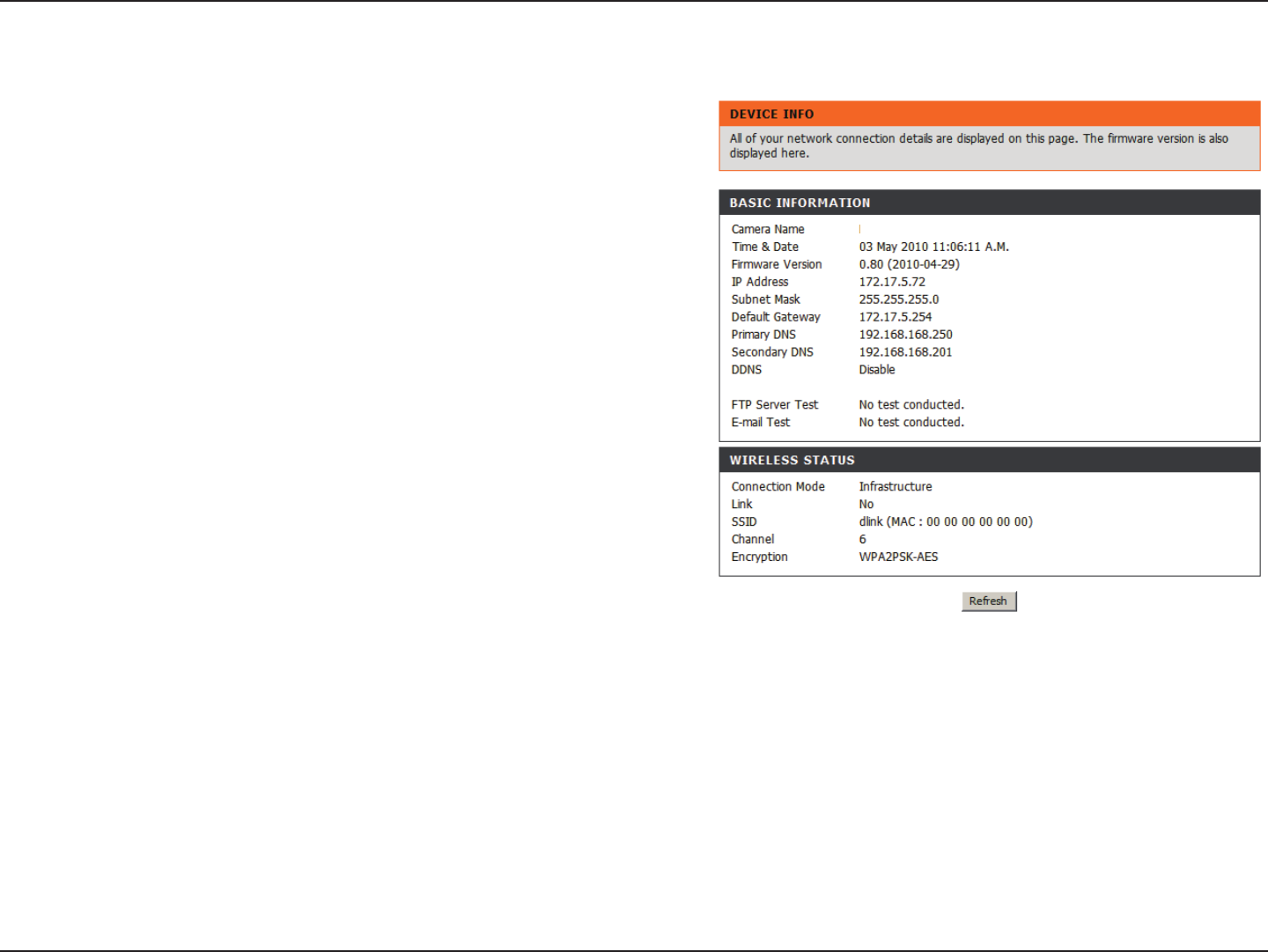
34D-Link DCS-932 User Manual
Section 3 - Configuration
Status > Device Info
This section displays all the details information about your
device and network settings.
DCS-932
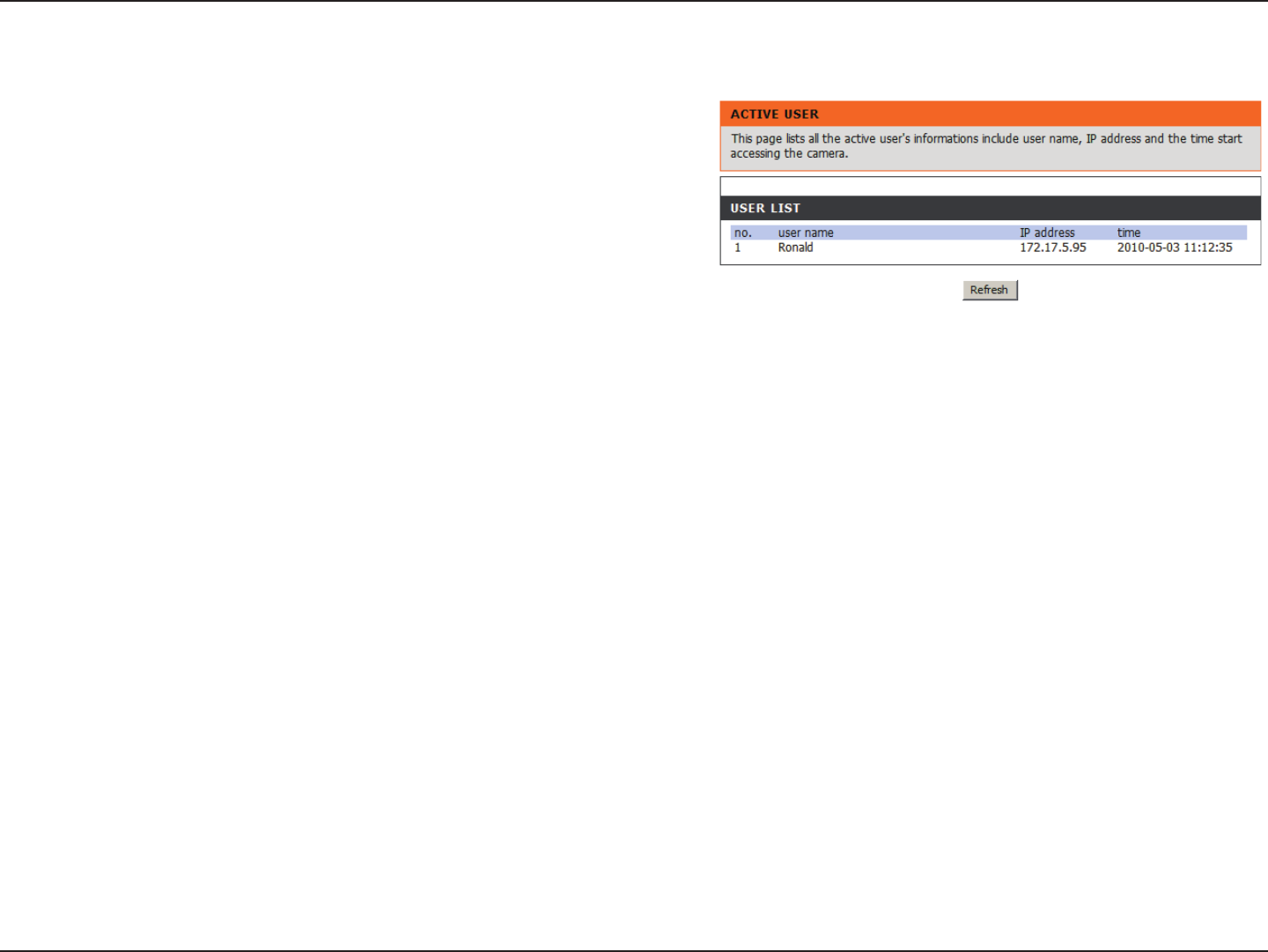
35D-Link DCS-932 User Manual
Section 3 - Configuration
Status > Active User
This page lists all the active user’s information including the User
Name, IP address, and the time that camera access began.

36D-Link DCS-932 User Manual
Section 3 - Configuration
D-Link’s DCS-932 is a versatile and cost effective Network Camera for video monitoring. It can also serve as a powerful surveillance
system in security applications. The DCS-932 can be used with any wired or 802.11n wireless router. This section explains how to view
the camera from either the Internet or from inside your internal network.
Materials Needed:
• 1 DCS-932 Network Camera
• 1 Ethernet Cable
• A Wired or Wireless router such as the D-Link DI-624 Wireless Router
• Ethernet based PC for system conguration
Setting Up the DCS-932 For Use Behind a Router
Installing a DCS-932 Network Camera on your network is an easy 4–step procedure:
1. Assign a Local IP Address to Your Network Camera
2. View the Network Camera Using Your Internet Explorer Web Browser
3. Access the Router with Your Web Browser
4. Open Virtual Server Ports to Enable Remote Image Viewing
This section is designed to walk you through the setup process for installing your camera behind a router and enable remote video
viewing. For the basic setup of the DCS-932, follow the steps outlined in the Quick Installation Guide.
Using & Conguring the DCS-932
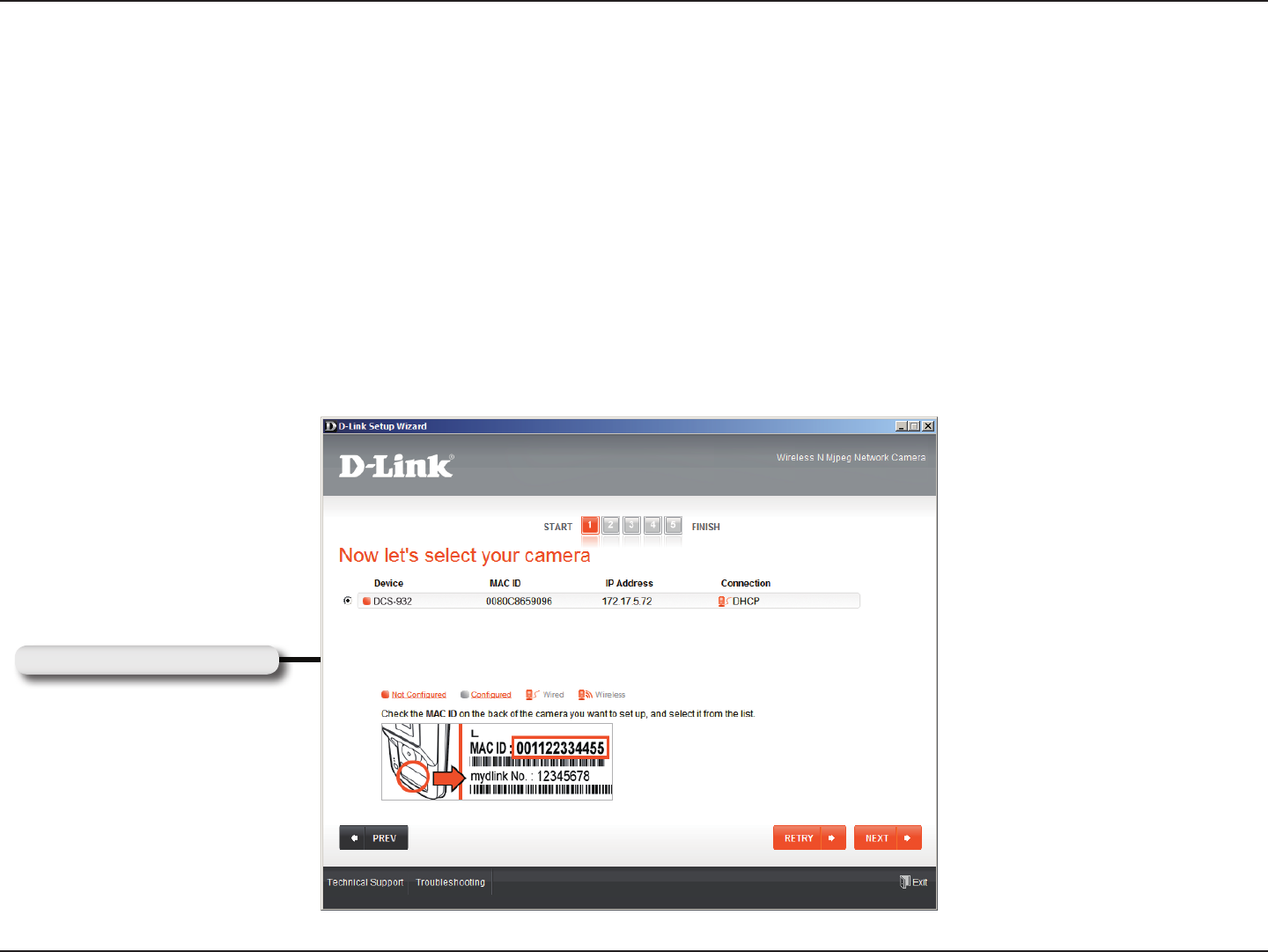
37D-Link DCS-932 User Manual
Section 3 - Configuration
Run the Setup Wizard program from the CD included with the DCS-932. Follow the steps in the Quick Installation Guide to congure the
DCS-932. The camera will be assigned a local IP Address that allows it to be recognized by the router. Write down this IP Address for
future reference.
1. Assign a Local IP Address to Your Camera
After you have completed the setup of the DCS-932 outlined in the Quick Installation Guide you will have an operating camera that has
an assigned IP Address. Because you are using a router to share the Internet with one or more PCs, the IP Address assigned to the
Network Camera will be a local IP Address. This allows viewing within your Local Area Network (LAN) until the router is congured to
allow remote viewing of the camera over the Internet.
This is the IP Address assigned to your camera (192.168.0.120 is only an example). You will probably have a different IP Address.
Your Camera’s IP Address
DCS-932
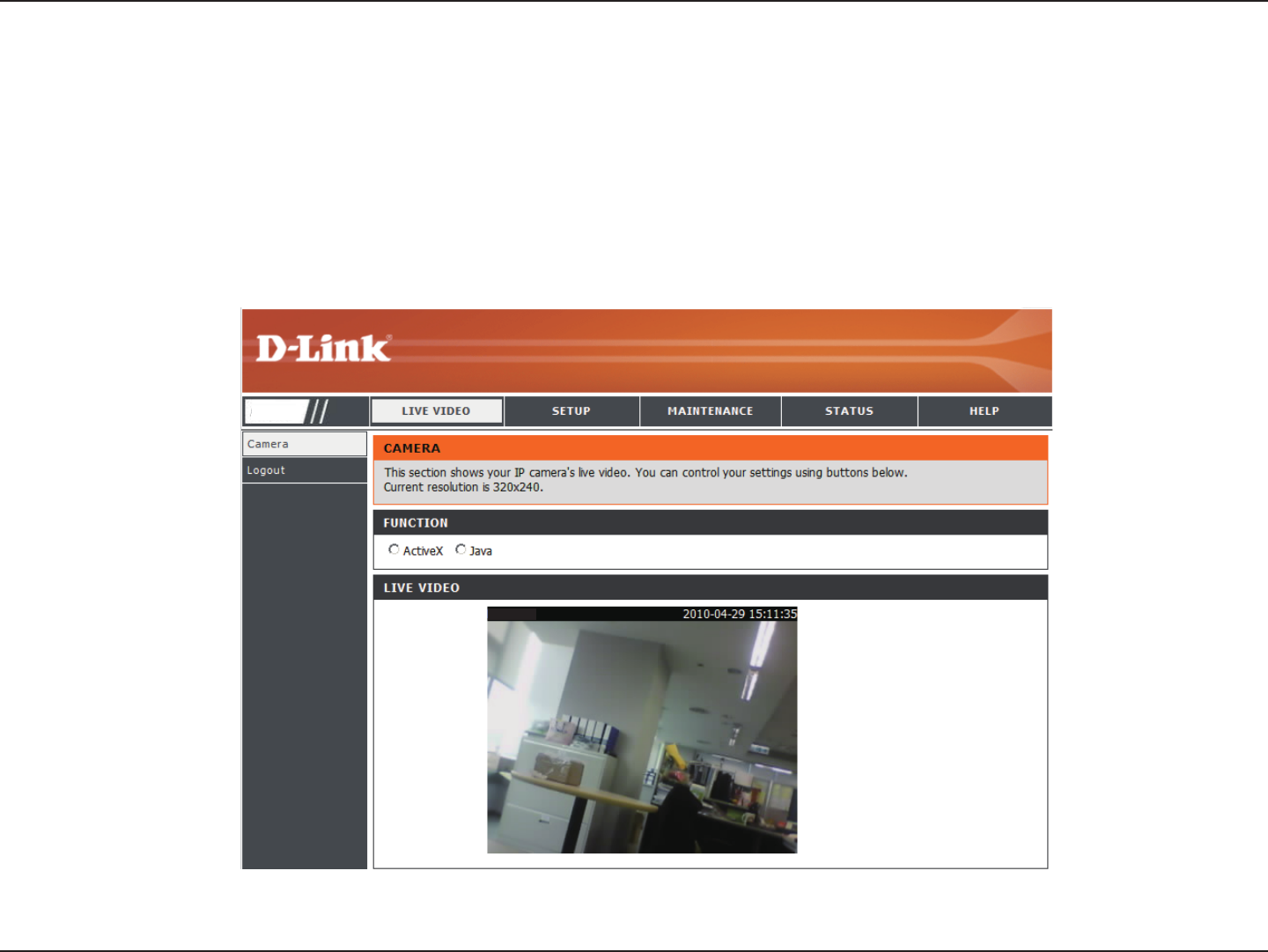
38D-Link DCS-932 User Manual
Section 3 - Configuration
Run your Internet Explorer Web browser. In the address bar, type in the IP Address that was assigned to the Network Camera by the
Installation Wizard program. The DCS-932 Home Page appears with a window displaying live video from the camera. You are able to
view this screen from any PC running Internet Explorer on your LAN.
Click on the Conguration button on the left side of the display. Scroll to the bottom of the Network Conguration page to display the ports
used by HTTP and Streaming video.
2. View the Network Camera Using Your Internet Explorer Web Browser
DCS-932
DCS-932

39D-Link DCS-932 User Manual
Section 4 - Security
Wireless Security
This section will show you the different levels of security you can use to protect your data from intruders.
The DCS-932 offers the following types of security:
• WPA-PSK (Pre-Shared Key)
• WEP (Wired Equivalent Privacy)
What is WEP?
WEP stands for Wired Equivalent Privacy. It is based on the IEEE 802.11 standard and uses the RC4 encryption algorithm. WEP provides
security by encrypting data over your wireless network so that it is protected as it is transmitted from one wireless device to another.
To gain access to a WEP network, you must know the key. The key is a string of characters that you create. When using WEP, you must
determine the level of encryption. The type of encryption determines the key length. 128-bit encryption requires a longer key than 64-
bit encryption. Keys are dened by entering in a string in HEX (hexadecimal - using characters 0-9, A-F) or ASCII (American Standard
Code for Information Interchange – alphanumeric characters) format. ASCII format is provided so you can enter a string that is easier to
remember. The ASCII string is converted to HEX for use over the network. Four keys can be dened so that you can change keys easily.

40D-Link DCS-932 User Manual
Section 4 - Security
What is WPA?
WPA, or Wi-Fi Protected Access, is a Wi-Fi standard that was designed to improve the security features of WEP (Wired Equivalent Privacy).
The 2 major improvements over WEP:
Improved data encryption through the Temporal Key Integrity Protocol (TKIP). TKIP scrambles the keys using a hashing algorithm
and, by adding an integrity-checking feature, ensures that the keys haven’t been tampered with. WPA2 is based on 802.11i
and uses Advanced Encryption Standard instead of TKIP.
User authentication, which is generally missing in WEP, through the extensible authentication protocol (EAP). WEP regulates
access to a wireless network based on a computer’s hardware-specic MAC address, which is relatively simple to be sniffed
out and stolen. EAP is built on a more secure public-key encryption system to ensure that only authorized network users can
access the network.
WPA-PSK/WPA2-PSK uses a passphrase or key to authenticate your wireless connection. The key is an alpha-numeric password between
8 and 63 characters long. The password can include symbols (!?*&_) and spaces. This key must be the exact same key entered on your
wireless router or access point.

41D-Link DCS-932 User Manual
Section 4 - Security
D-Link’s DCS-932 is a versatile and cost effective Network Camera offering both video and audio monitoring. It can also serve as a powerful
surveillance system in security applications. The DCS-932 can be used with any wired or 802.11n/g wireless router. This section explains
how to view the camera from either the Internet or from inside your internal network.
Materials Needed:
• 1 DCS-932 Network Camera
• 1 Ethernet Cable
• A Wired or Wireless router such as the D-Link DIR-655 Wireless Router
• Ethernet based PC for system conguration
Setting up the DCS-932 for Use Behind a Router
Installing a DCS-932 Network Camera on your network is an easy 4–step procedure:
1. Assign a Local IP Address to Your Network Camera
2. View the Network Camera Using Your Internet Explorer Web Browser
3. Access the Router with Your Web Browser
4. Open Virtual Server Ports to Enable Remote Image Viewing
This section is designed to walk you through the setup process for installing your camera behind a router and enable remote video viewing.
For the basic setup of the DCS-932, follow the steps outlined in the Quick Installation Guide.
After you have completed the setup of the DCS-932 outlined in the Quick Installation Guide you will have an operating camera that has an
assigned IP Address. Because you are using a router to share the Internet with one or more PCs, the IP Address assigned to the Network
Camera will be a local IP Address. This allows viewing within your Local Area Network (LAN) until the router is congured to allow remote
viewing of the camera over the Internet.
Using & Conguring the DCS-932 with a NAT Router

42D-Link DCS-932 User Manual
Section 4 - Security
1. Assign a Local IP Address to Your Camera
Run the setup wizard from the CD included with the DCS-932. Follow the steps in the Quick Installation Guide to congure the DCS-932.
The camera will be assigned a local IP Address that allows it to be recognized by the router. Write down this IP Address for future reference.

43D-Link DCS-932 User Manual
Section 4 - Security
Run your Internet Explorer Web browser. In the address bar, type in the IP Address that was assigned to the Network Camera by the DCC
program. The DCS-932 Live Video Page appears with a window displaying live video from the camera. You are able to view this screen
from any PC running Internet Explorer on your LAN.
Click on the Setup button on the left side of the display. Scroll to the bottom of the Network Setup page (see page 18) to display the ports
used by HTTP and Streaming audio and video.
2. View the Network Camera Using Your Internet Explorer Web Browser
DCS-932
DCS-932
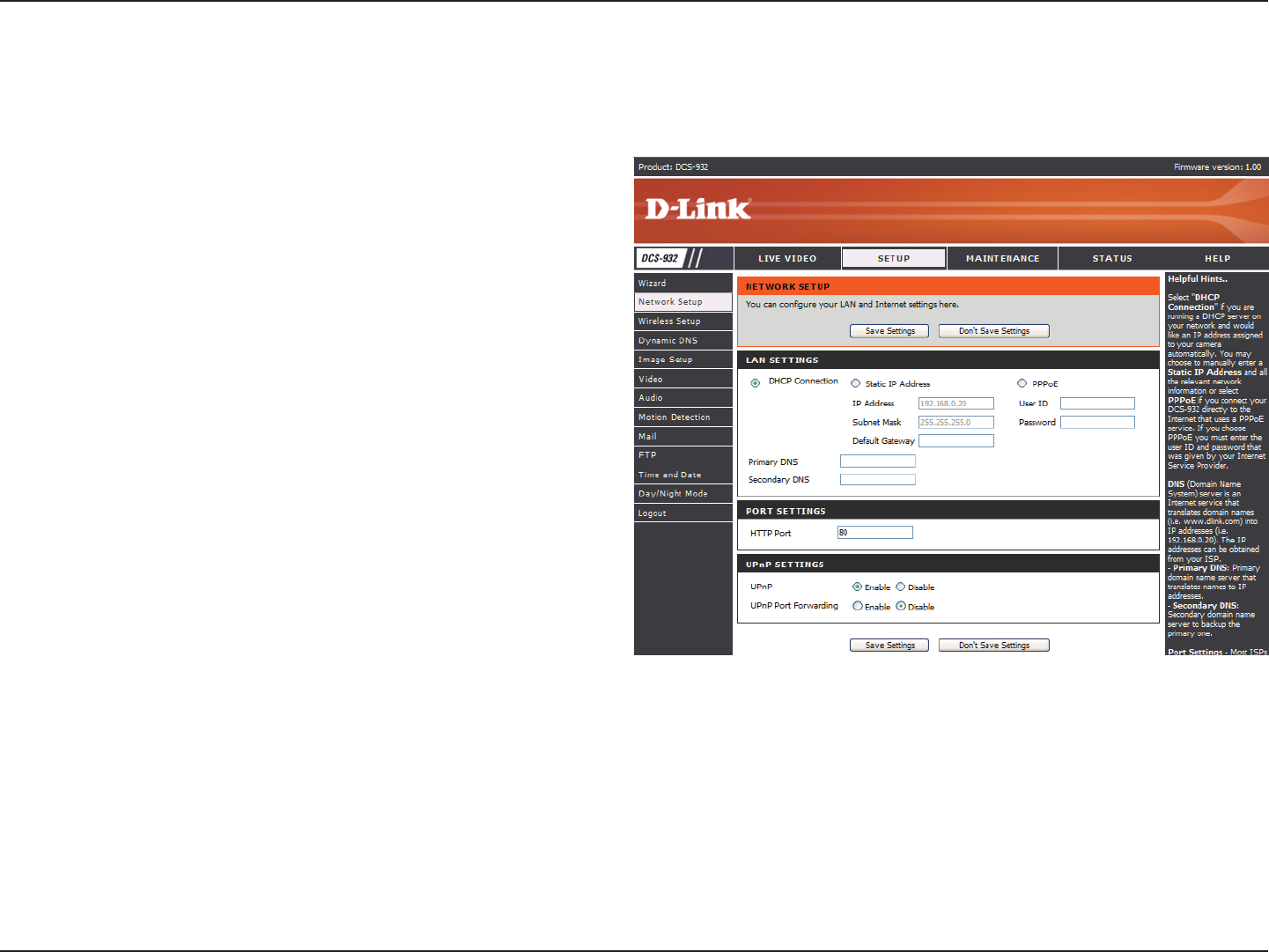
44D-Link DCS-932 User Manual
Section 4 - Security
The Setup > Network Setup page displays the port settings for your camera. If necessary, these ports can be changed if they are already
in use by other devices (e.g. in a multiple camera environment).
Note: Both the HTTP port and RTSP port are required to be opened
for the DCS-932.
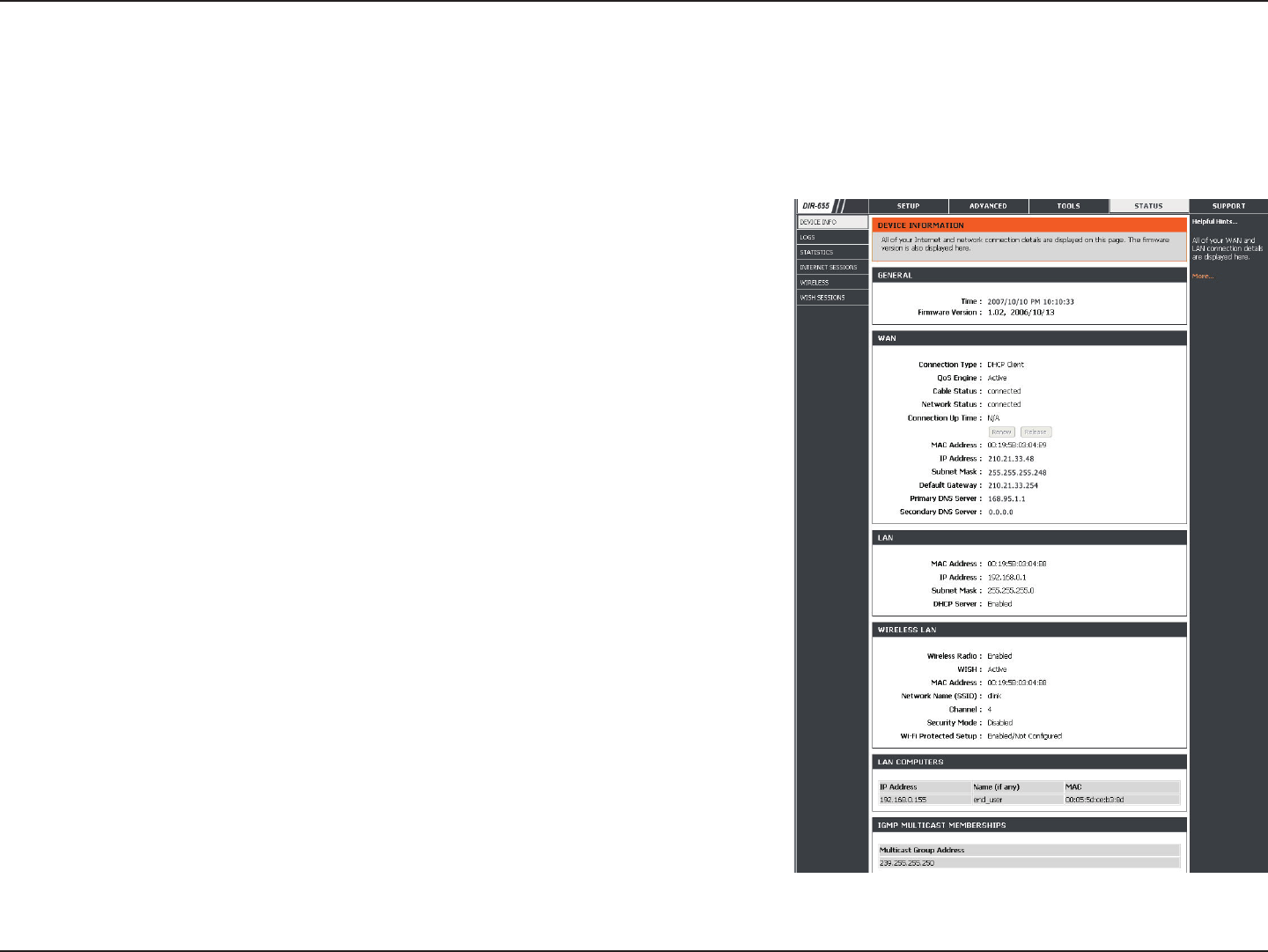
45D-Link DCS-932 User Manual
Section 4 - Security
The following steps generally apply to any router that you have on your network. The D-Link DIR-655 is used as an example to clarify the
conguration process. Congure the initial settings of the DIR-655 by following the steps outlined in the DIR-655 Quick Installation Guide.
3. Access the Router with Your Web Browser
If you have cable or DSL Internet service, you will most likely have a dynamically
assigned WAN IP Address. ‘Dynamic’ means that your router’s WAN IP address
can change from time to time depending on your ISP. A dynamic WAN IP Address
identies your router on the public network and allows it to access the Internet. To
nd out what your router’s WAN IP Address is, go to the Status menu on your router
and locate the WAN information for your router (as shown on the next page). The
WAN IP Address will be listed. This will be the address that you will need to type in
your Web browser to view your camera over the Internet.
Router Set-Up and Installation
Your WAN IP Address will be listed on the router’s
Status > Device Info page.

46D-Link DCS-932 User Manual
Section 4 - Security
Note: Because a dynamic WAN IP can change from time to time depending on your ISP, you may want to obtain a Static IP address from
your ISP. A Static IP address is a xed IP address that will not change over time and will be more convenient for you to use to access your
camera from a remote location. The Static IP Address will also allow you to access your camera attached to your router over the Internet.
4. Open Virtual Server Ports to Enable Remote Image Viewing
The rewall security features built into the DIR-655 router prevent users from accessing the video from the DCS-932 over the Internet. The
router connects to the Internet over a series of numbered ports. The ports normally used by the DCS-932 are blocked from access over
the Internet. Therefore, these ports need to be made accessible over the Internet. This is accomplished using the Virtual Server function
on the DIR-655 router. The Virtual Server ports used by the camera must be opened through the router for remote access to your camera.
Virtual Server is accessed by clicking on the Advanced tab of the router screen.
1. Click Enabled.
2. Enter a different name for each entry.
3. Enter your camera’s local IP Address (e.g., 192.168.0.120) in the Private IP eld.
4. Select TCP for HTTP port, both (TCP and UDP) for RTSP and both (TCP and UDP) for 5556 - 5559 ports.
5. If you are using the default camera port settings, enter 80 into the Public and Private Port section, click Apply.
6. Scheduling should be set to Always so that the camera images can be accessed at any time.
Follow these steps to congure your router’s Virtual Server settings:
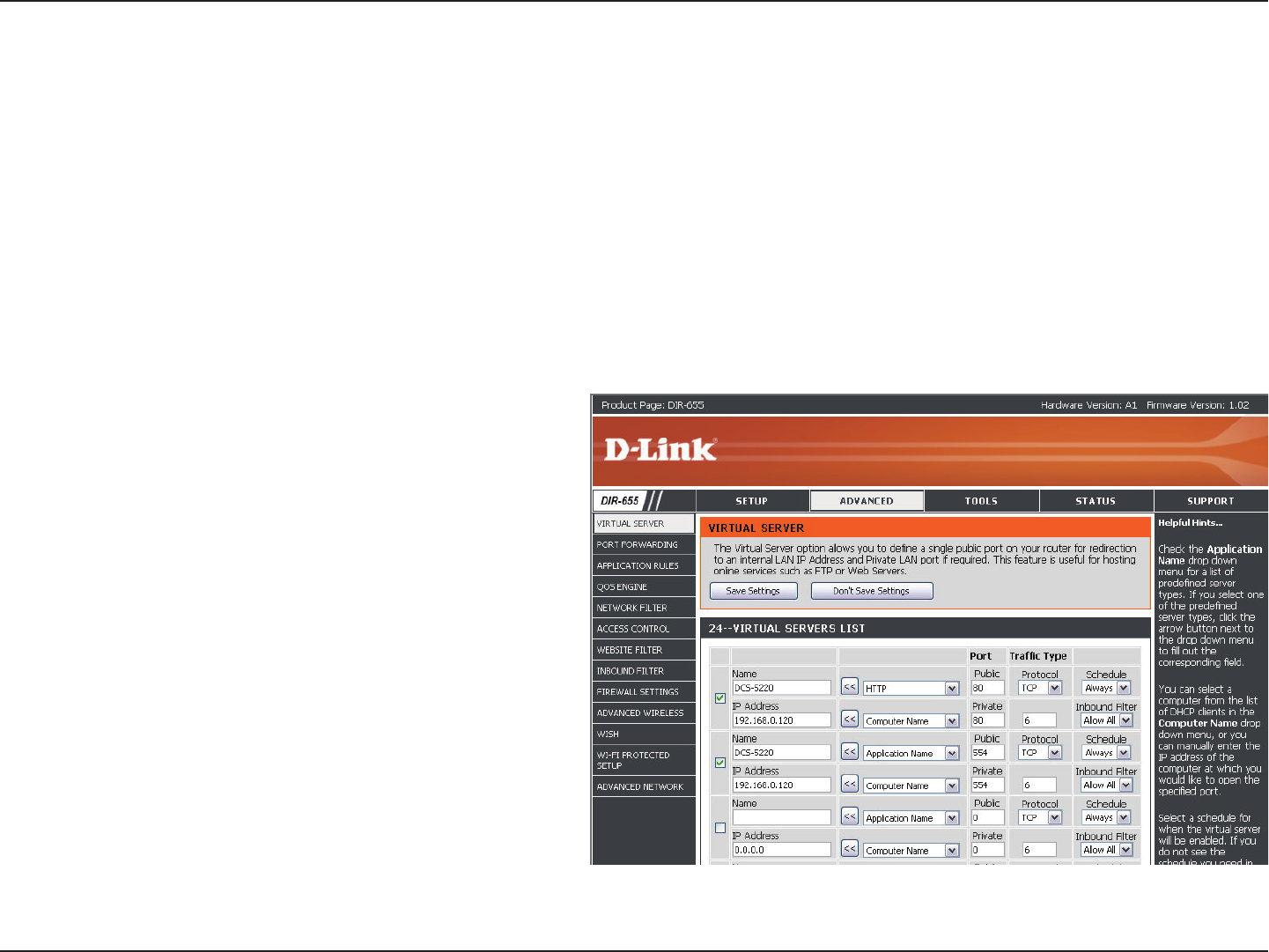
47D-Link DCS-932 User Manual
Section 4 - Security
Repeat the above steps adding the port 554 to both the Public and Private Port sections. A check mark appearing before the entry name
will indicate that the ports are enabled.
Important: Some ISPs block access to port 80 and other commonly used Internet ports to conserve bandwidth. Check with your ISP so
that you can open the appropriate ports accordingly. If your ISP does not pass trafc on port 80, you will need to change the port the
camera uses from 80 to something else, such as 800. Not all routers are the same, so refer to your user manual for specic instructions
on how to open ports.
Enter valid ports in the Virtual Server section of your router. Please make sure to check the box next to the camera name on the Virtual
Server List to enable your settings.

48D-Link DCS-932 User Manual
Section 5 - Troubleshooting
Troubleshooting
1. Why does the LED not light up?
The power supply might be faulty. Conrm that you are using the provided DC 5V power supply for this network camera. Verify that the
power supply is correctly connected. If the camera is functioning normally, the LED may have been disabled. See page 30 for information
about how to enable the LED.
2. Why is the camera’s network connection unreliable?
There might be a problem with the network cable. To conrm that the cables are working, PING the address of a known device on the
network. If the cabling is OK and your network is reachable, you should receive a reply similar to the following (…bytes = 32 time = 2 ms).
Another possible problem may be that the network device such as a hub or switch utilized by the Network Camera is not functioning
properly. Please conrm the power for the devices are well connected and functioning properly.
3. Why does the Network Camera work locally but not remotely?
This might be caused by the rewall protection. Check the Internet rewall with your system administrator. The rewall may need to have
some settings changed in order for the Network Camera to be accessible outside your local LAN. For more information, please refer to
the section about installing your camera behind a router.
Make sure that the Network Camera isn’t conicting with any Web server you may have running on your network.
The default router setting might be a possible reason. Check that the conguration of the router settings allow the Network Camera to be
accessed outside your local LAN.
4. Why does a series of broad vertical white lines appear through out the image?
It could be that the CMOS sensor (a square panel situated behind the lens that measures the light signals and changes it into a digital
format so your computer can present it into an image that you are familiar with) has become overloaded when it has been exposed to
bright lights such as direct exposure to sunlight or halogen lights. Reposition the Network Camera into a more shaded area immediately
as prolonged exposure to bright lights will damage the CMOS sensor.

49D-Link DCS-932 User Manual
Section 5 - Troubleshooting
5. The camera is producing noisy images. How can I solve the problem?
The video images might be noisy if the Network Camera is used in a very low light environment.
6. The images are poor quality, how can I improve the image quality?
Make sure that your computer’s display properties are set to at least 6-bit color. Using 16 or 256 colors on your computer will produce
dithering artifacts in the image, making the image look as if it is of poor quality.
The conguration on the Network Camera image display is incorrect. The Web Conguration Video section of the Web management allows
you to adjust the related-parameters for improved images such as: brightness, contrast, hue and light frequency. Please refer to the Web
Conguration section for detailed information.
7. Why are no images available through the Web browser?
ActiveX might be disabled. If you are viewing the images from Internet Explorer make sure ActiveX has been enabled in the Internet Options
menu. You may also need to change the security settings on your browser to allow the ActiveX plug-in to be installed.
If you are using Internet Explorer with a version number lower than 6, then you will need to upgrade your Web browser software in order
to view the streaming video transmitted by the Network Camera.

50D-Link DCS-932 User Manual
Appendix A - Wireless Basics
D-Link wireless products are based on industry standards to provide easy-to-use and compatible high-speed wireless* connectivity within
your home, business or public access wireless networks. Strictly adhering to the IEEE standard, the D-Link wireless family of products
will allow you to securely access the data you want, when and where you want it. You will be able to enjoy the freedom that wireless
networking delivers.
A wireless local area network (WLAN) is a cellular computer network that transmits and receives data with radio signals instead of wires.
Wireless LANs are used increasingly in both home and ofce environments, and public areas such as airports, coffee shops and universities.
Innovative ways to utilize WLAN technology are helping people to work and communicate more efciently. Increased mobility and the
absence of cabling and other xed infrastructure have proven to be benecial for many users.
Under many circumstances, it may be desirable for mobile network devices to link to a conventional Ethernet LAN in order to use servers,
printers or an Internet connection supplied through the wired LAN. A Wireless Router is a device used to provide this link.
Wireless Basics

51D-Link DCS-932 User Manual
Appendix A - Wireless Basics
What is Wireless?
Wireless or WiFi technology is another way of connecting your computer to the network without using wires. WiFi uses radio frequency to
connect wirelessly, so you have the freedom to connect computers anywhere in your home or ofce network.
Why D-Link Wireless?
D-Link is the worldwide leader and award winning designer, developer, and manufacturer of networking products. D-Link delivers the
performance you need at a price you can afford. D-Link has all the products you need to build your network.
How does wireless work?
Wireless works similar to how cordless phone work, through radio signals to transmit data from one point A to point B. But wireless
technology has restrictions as to how you can access the network. You must be within the wireless network range area to be able to
connect your computer. There are two different types of wireless networks Wireless Local Area Network (WLAN), and Wireless Personal
Area Network (WPAN).
Wireless Local Area Network (WLAN)
In a wireless local area network, a device called an Access Point (AP) connects computers to the network. The access point has a small
antenna attached to it, which allows it to transmit data back and forth over radio signals. With an indoor access point as seen in the picture,
the signal can travel up to 300 feet. With an outdoor access point the signal can reach out up to 30 miles to serve places like manufacturing
plants, industrial locations, college and high school campuses, airports, golf courses, and many other outdoor venues.

52D-Link DCS-932 User Manual
Appendix A - Wireless Basics
Who uses wireless?
Wireless technology as become so popular in recent years that almost everyone is using it, whether it’s for home, ofce, business, D-Link
has a wireless solution for it.
Home
• Gives everyone at home broadband access
• Surf the Web, check email, instant message, and etc
• Gets rid of the cables around the house
• Simple and easy to use
Small Ofce and Home Ofce
• Stay on top of everything at home as you would at ofce
• Remotely access your ofce network from home
• Share Internet connection and printer with multiple computers
• No need to dedicate ofce space

53D-Link DCS-932 User Manual
Appendix A - Wireless Basics
Where is wireless used?
Wireless technology is expanding everywhere not just at home or ofce. People like the freedom of mobility and it’s becoming so popular
that more and more public facilities now provide wireless access to attract people. The wireless connection in public places is usually
called “hotspots”.
Using a D-Link Cardbus Adapter with your laptop, you can access the hotspot to connect to Internet from remote locations like: Airports,
Hotels, Coffee Shops, Libraries, Restaurants, and Convention Centers.
Wireless network is easy to setup, but if you’re installing it for the rst time it could be quite a task not knowing where to start. That’s why
we’ve put together a few setup steps and tips to help you through the process of setting up a wireless network.
Tips
Here are a few things to keep in mind, when you install a wireless network.
Centralize your router or Access Point
Make sure you place the router/access point in a centralized location within your network for the best performance. Try to place the router/
access point as high as possible in the room, so the signal gets dispersed throughout your home. If you have a two-story home, you may
need a repeater to boost the signal to extend the range.
Eliminate Interference
Place home appliances such as cordless telephones, microwaves, and televisions as away as possible from the router/access point. This
would signicantly reduce any interfere that the appliances might cause since they operate on same frequency.
Security
Don’t let you next-door neighbors or intruders connect to your wireless network. Secure your wireless network by turning on the WPA or
WEP security feature on the router. Refer to product manual for detail information on how to set it up.

54D-Link DCS-932 User Manual
Appendix A - Wireless Basics
There are basically two modes of networking:
• Infrastructure – All wireless clients will connect to an access point or wireless router.
• Ad-Hoc – Directly connecting to another computer, for peer-to-peer communication, using wireless network adapters on each computer, such as
two or more DCS-932 wireless network Cardbus adapters.
An Infrastructure network contains an Access Point or wireless router. All the wireless devices, or clients, will connect to the wireless router or
access point.
An Ad-Hoc network contains only clients, such as laptops with wireless cardbus adapters. All the adapters must be in Ad-Hoc mode to
communicate.
Wireless Modes
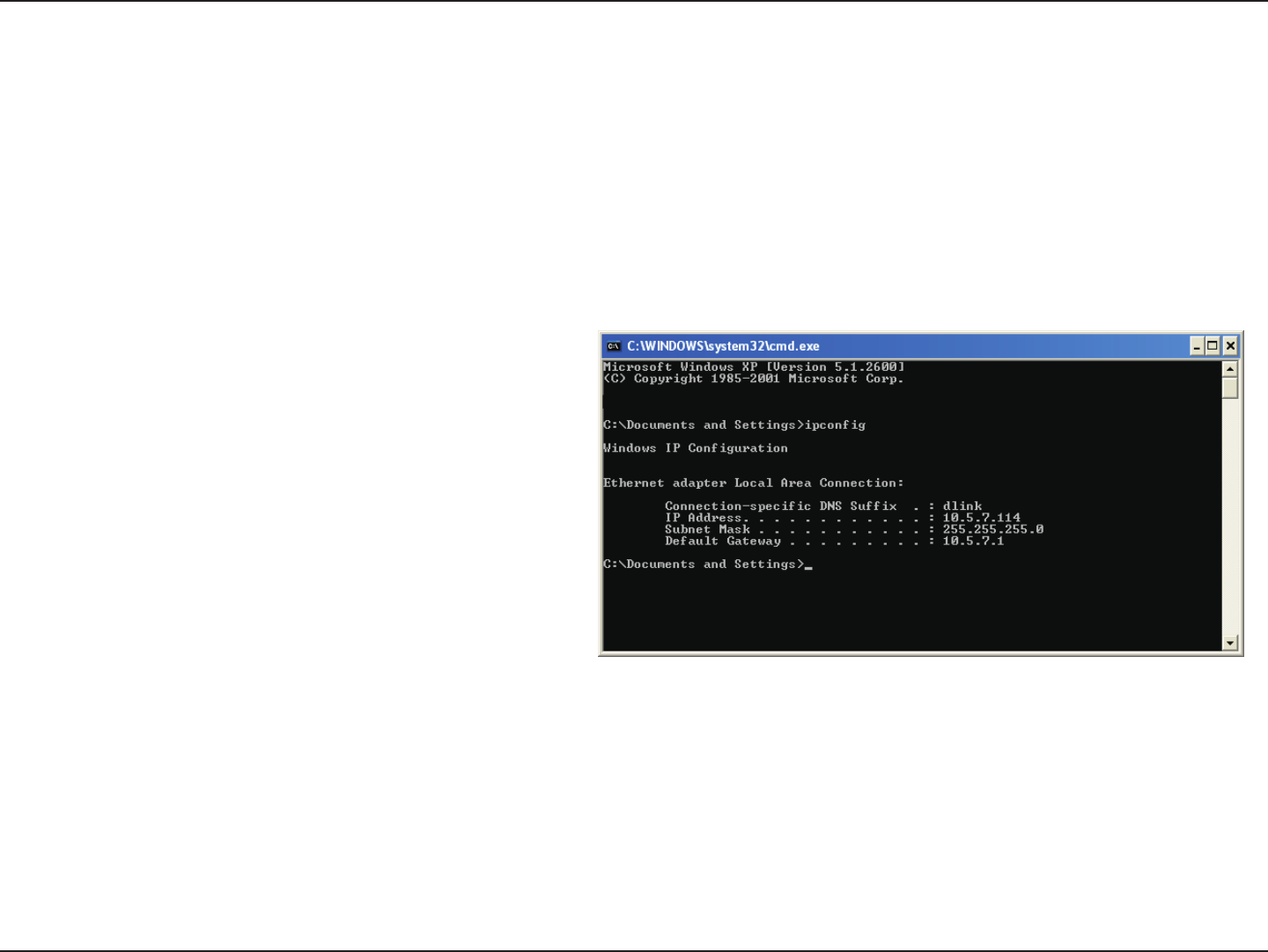
55D-Link DCS-932 User Manual
Appendix B - Networking Basics
Networking Basics
Check your IP address
After you install your new D-Link adapter, by default, the TCP/IP settings should be set to obtain an IP address from a DHCP server (i.e.
wireless router) automatically. To verify your IP address, please follow the steps below.
Click on Start > Run. In the run box type cmd and click OK.
At the prompt, type ipcong and press Enter.
This will display the IP address, subnet mask, and the default
gateway of your adapter.
If the address is 0.0.0.0, check your adapter installation,
security settings, and the settings on your router. Some
rewall software programs may block a DHCP request on
newly installed adapters.
If you are connecting to a wireless network at a hotspot (e.g.
hotel, coffee shop, airport), please contact an employee or administrator to verify their wireless network settings.

56D-Link DCS-932 User Manual
Appendix B - Networking Basics
Statically Assign an IP address
If you are not using a DHCP capable gateway/router, or you need to assign a static IP address, please follow the steps below:
Step 1
Windows® Vista - Click on Start > Control Panel > Network and Internet > Network and Sharing Center > Manage Network Connections.
Windows XP - Click on Start > Control Panel > Network Connections.
Step 2
Right-click on the Local Area Connection which represents your D-Link network adapter and select Properties.
Step 3
Highlight Internet Protocol (TCP/IP) and click Properties.
Step 4
Click Use the following IP address and enter an IP address that is on the same subnet as your
network or the LAN IP address on your router.
Example: If the router´s LAN IP address is 192.168.0.1, make your IP address 192.168.0.X where X
is a number between 2 and 99. Make sure that the number you choose is not in use on the network.
Set Default Gateway the same as the LAN IP address of your router (192.168.0.1).
Set Primary DNS the same as the LAN IP address of your router (192.168.0.1). The Secondary DNS
is not needed or you may enter a DNS server from your ISP.
Step 5
Click OK twice to save your settings.

57D-Link DCS-932 User Manual
Appendix C - Technical Specifications
Technical Specications
SYSTEM REQUIREMENTS
• Operating System: Microsoft Windows XP, Vista, Windows 7
• Internet Explorer 6 or above , Firefox 3.5 or above, Safari 4
NETWORKING PROTOCOL
• IPV4, ARP, TCP, UDP, ICMP
• DHCP Client
• NTP Client (D-Link)
• DNS Client
• DDNS Client (Dyndns and D-Link)
• SMTP Client
• FTP Client
• HTTP Server
• PPPoE
• UPnP Port Forwarding
• LLTD
BUILT-IN NETWORK INTERFACE
• 10/100BASE-TX Fast Ethernet
• 802.11b/g/n WLAN
WIRELESS CONNECTIVITY
• 802.11b/g/n Wireless with WEP/WPA/WPA2 security
WIRELESS TRANSMIT OUTPUT POWER
• 16 dbm for 11b, 12 dbm for 11g,
12 dbm for 11n (typical)
SDRAM
• 32 MB
FLASH MEMORY
• 4 MB
RESET BUTTON
• Reset to factory default
VIDEO CODECS
• MJPEG
• JPEG for still images
VIDEO FEATURES
• Adjustable image size and quality
• Time stamp and text overlay
• Flip and Mirror
RESOLUTION
• 640 x 480 at up to 20 fps
• 320 x 240 at up to 30 fps
• 160 x 120 at up to 30 fps

58D-Link DCS-932 User Manual
Appendix C - Technical Specifications
LENS
• Focal length: 5.01 mm, F2.8
SENSOR
• VGA 1/5 inch CMOS Sensor
MINIMUM ILLUMINATION
• 1 lux @ F2.8
VIEW ANGLE
• Horizontal: 45.3°
• Vertical: 34.5°
• Diagonal: 54.9°
DIGITAL ZOOM
• Up to 4x
3A CONTROL
• AGC (Auto Gain Control)
• AWB (Auto White Balance)
• AES (Auto Electronic Shutter)
POWER
• Input: 100-240 V AC, 50/60 Hz
• Output: 5 V DC, 1.2 A
• External AC-to-DC switching power adapter
DIMENSIONS (W X D X H)
• Including the bracket and stand:
65.8 x 65 x 126 mm
• Camera only:
27.2 x 60 x 96 mm
WEIGHT
• 76.9 g (without bracket and stand)
MAX POWER CONSUMPTION
• 2 W
OPERATION TEMPERATURE
• 0 ˚C to 40 ˚C (32 ˚F to 104 ˚F)
STORAGE TEMPERATURE
• -20 ˚C to 70 ˚C (-4 ˚F to 158 ˚F)
HUMIDITY
• 20-80% RH non-condensing
EMISSION (EMI), SAFETY & OTHER CERTIFICATIONS
• FCC Class B
• IC
• C-Tick
• CE
FCC Notices
This device complies with Part 15 of the FCC Rules. Operation is subject to the following
two conditions: (1) this device may not cause harmful interference, and (2) this device
must accept any interference received, including interference that may cause undesired
operation.
CAUTION: Change or modification not expressly approved by the party responsible
for compliance could void the user’s authority to operate this equipment.
This equipment has been tested and found to comply with the limits for a Class B
digital device, pursuant to Part 15 of the FCC Rules. These limits are designed to provide
reasonable protection against harmful interference in a residential installation. This
equipment generates, uses and can radiate radio frequency energy and, if not installed
and used in accordance with the instructions, may cause harmful interference to radio
communications. However, there is no guarantee that interference will not occur in a
particular installation. If this equipment does cause harmful interference to radio or
television reception, which can be determined by turning the equipment off and on, the
user is encouraged to try to correct the interference by one or more of the following
measures:
--Reorient or relocate the receiving antenna.
--Increase the separation between the equipment and receiver.
--Connect the equipment into an outlet on a circuit different from that to which the receiver
is connected.
--Consult the dealer or an experienced radio/TV technician for help.
CAUTION:
Any changes or modifications not expressly approved by the grantee of this device could
void the user's authority to operate the equipment.
RF exposure warning
This equipment must be installed and operated in accordance with provided instructions
and the antenna(s) used for this transmitter must be installed to provide a separation
distance of at least 20 cm from all persons and must not be co-located or operating in
conjunction with any other antenna or transmitter. End-users and installers must be
provide with antenna installation instructions and transmitter operating conditions for
satisfying RF exposure compliance."
Canada Notices
Industry Canada regulatory information
Operation is subject to the following two conditions: (1) this device may not cause
interference, and (2) this device must accept any interference, including interference
that may cause undesired operation of the device.
The user is cautioned that this device should be used only as specified within this
manual to meet RF exposure requirements. Use of this device in a manner
inconsistent with this manual could lead to excessive RF exposure conditions.